






The ASUCD is facing a roughly $200,000 difference between expected income and expenses
BY VINCE BASADA campus@theaggie.org
The ASUCD entered several days of budget hearings from March 6 to 9, ultimately approving cuts to several units and committees but not completely bridging the gap between projected incomes and expenses.
As of time of publication, ASUCD’s projected income for the 2025-26 academic year (AY) is $18,162,968, with an extra $5,639,078 expected from student fees. Total projected expenses, including salaries and wages, is $24,003,878. The result is a difference of $201,832.
Te diference at the end of the frst day of budget hearings was roughly $164,000, meaning that it had increased by some $37,000 by March 9.
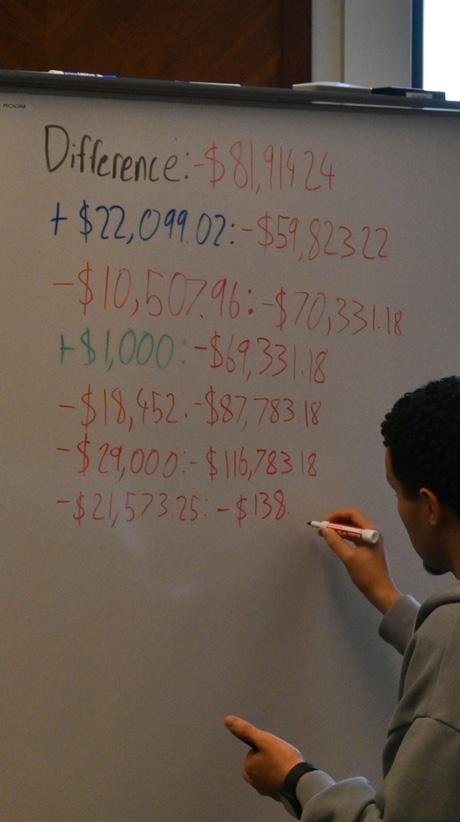
ASUCD Controller Mostafa Rasheed updates the figures for the Association’s difference between expected income and expenditures at the March 8 Budget Hearing. As of time of publication, the difference is just over $201,832.
(Julia Heron-Watts / Aggie)
T e proposed budget presented by ASUCD President Gaius Ilupeju, who also serves as the ASUCD’s chief executive officer, included several austerity measures. One reason for the cuts was a decrease in allocation from student services to the ASUCD, resulting in a tighter budget going into the next year, according to ASUCD Controller Mostafa Rasheed.
Other justifcations cited during the hearings included lower-thanexpected profits from the Coffee House and Unitrans, low advertising revenues from Te California Aggie — which is managed independently from the student government but relies on student funds — and other reductions in income streams.
Cuts made include the elimination of the Planet Her Committee, responsible for planning the female empowerment event frst held in 2023, and the Aggie Mentors Committee. Expenses for the PRIDE unit were also reduced, now down to $12,500 from $20,250 in academic year 2024-25.
Unit directors and committee chairs from Picnic Day to Te Pantry advocated throughout the several days of hearings for budgets they believed would best suit the needs of their organization, to varying levels of success. The amendments and changes to the proposed budget are administered by the 12 voting student senators, alongside the International and Transfer Student Representatives, as per the ASUCD Constitution. Budgets for each ASUCD unit and committee are ultimately determined by these student ofcers, with some exceptions for certain independent units.
ASUCD acts as both an employer of and the governing body for the undergraduate student population, with roughly 1,000 employees across its ranks. Te highest budgeted units for the upcoming school year are Unitrans (allotted $9.9 million), the Cofee House (CoHo) ($6.3 million), ASUCD’s General Administration ($1.6 million) and the Entertainment Council ($640,000).
Current projected expenditure for Student Government is $516,884, plus an extra $90,000 allotted to the Senate Reserves. Additionally, the Executive
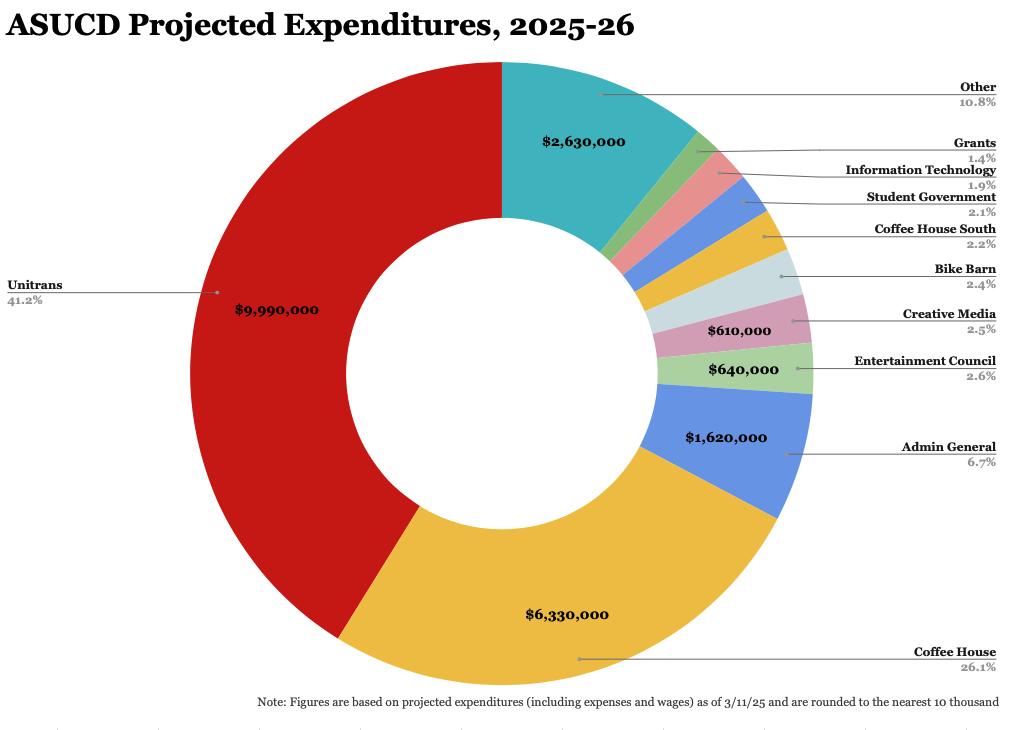
Editor’s Note: This pie chart is taken from the currently approved unit expenditures, the final numbers present are not the final data provided by ASUCD.
Branch, including the ofces of the President and Internal Vice President, is budgeted $118,000.
One measure in the proposed budget that was controversial amongst the table was the elimination of pay for students serving as members on student government committees (e.g. Undocuscholars Advocacy and Aid, STEM, Aggie Arts).
Discussion in favor of committee members’ pay was led by Internal Afairs Commission Chair Amanda Clark, Senate Pro Tempore Dhilena Wickramasinghe and Senator Amrita Julka, among others.
“As one of the two people [in the Senate] who actually has been in a committee, [committee members] do so much more work than most of the people on the [Senate] table right now,” Wickramasinghe said. “[For] people in commissions and committees, there’s so much more work than the three hours that they’re being allocated for”.
Committee member pay was ultimately secured, with a comment from Ilupeju that sacrifices would have to be made elsewhere to ofset the change.
Concerns were also raised over the instability and lack of grants, given the
current presidential administration, provided to ASUCD for events and other programs — especially those designed for women and people of color.
Tere are less grants available in order to put on all these events,” Gender and Sexuality Commission (GASC) Chair Tristen Dillard said. “We need Senate support.”
Tere were new budget items in this year’s budget, including funding for the newly created Vital Emergency Shelter and Transitional Assistance (VESTA) sub-unit, tasked with managing a new transitional housing shelter at Russell Park in association with Aggie House.
VESTA, part of the Housing Advising for Undergraduate Students unit, was allocated $51,842 for staf Te budget also allocates $80,000 for rental of the new Russell Park facility.
Te prospective budget was released two days before budget hearings on March 4, three days later than required by ASUCD bylaws — as noted by several unit directors and senators throughout the meetings. In an email to ASUCD leaders, Rasheed, the ASUCD’s chief f nancial o f cer, apologized for the delay and attributed it to “signifcant accounting challenges.”
Budget hearings have typically been
held in the last weeks of spring quarter but were moved up earlier this year to comply with university policy. Parts of the budget will likely be reviewed and reopened through the end of the year, including approval of the budgets of KDVS and The California Aggie. Both units were sent back to the Campus Media Board, the university’s independent governing body responsible for administration of those units, for further changes.
Tere is still a possibility of fxing the [ASUCD] budget if needed in spring quarter as this was a very early proposal,” Rasheed said in a statement to Te Aggie. “We will see as the quarter progresses.” T e f nal budget will be formally adopted during the first Senate meeting in fall quarter 2025 as part of Senate Bill #1. Te ASUCD budget for the AY 2024-25 can be found on the ASUCD website.
The organizations discussed increasing affordable housing and building mental health programs for students and community members
BY RORY CONLON
city@theaggie.org
Te city of Davis, UC Davis and Yolo County gave updates on campus housing and the Crisis Now program during their Feb. 25 meeting.
Two representatives from each of the three organizations meet annually to discuss issues in the Davis community and progress toward shared goals at the university, city and county level.
Tese meetings build and maintain connections between the university and the surrounding city, according to UC Davis Chancellor Gary May.
“Conversations like the ones we’ll have this evening are a vital part of the efort to ensure our town and gown
March 13 marks five years since the symbolic start of the COVID-19 pandemic in the U.S.

Students, professors comment on the lasting impact of the pandemic in professional
SEE PAGE 10
relationship remains a model for other communities,” May said. “Whether it’s our eforts to combat discrimination [through] the ‘Hate Free Together’ initiative, our partnership in building a more sustainable community or strengthening our transportation partnership, every challenge we face is more manageable when we face it together.”
In September 2018, UC Davis, Yolo County and the city of Davis agreed to a memorandum of understanding (MOU) that informed the school’s Long Range Development Plan (LRDP). Four main goals were identified, according to the LRDP Memorandum of Understanding webpage.
“Te terms of the MOU include a commitment to build more housing for students as well as a guarantee to house 100 percent of any new student enrollment growth on campus,” the webpage reads. “Te MOU also includes the development of joint transportation plans and trafc improvement projects, the elimination of master leases in the City of Davis and the formation of a stronger town-gown partnership through a variety of collaborative activities.”
In 2018, the blended vacancy rate for the city of Davis fell below 1%, leading to a severe shortage of afordable housing for students. However, Lucas Grifth, the UC Davis executive director of campus planning and sustainability, said that the school has exceeded goals for providing more housing to students in 2025.
“In 2025, we built a signifcant amount of housing or beds on campus,” Grifth said. “Te vacancy rate has increased to four percent.”
Griffith said the university has
also met its goals for accommodating enrollment growth.
“Since the passage of the LRDP, we have grown enrollment by 2,600 and we have built over 6,000 new beds,” Grifth said. “So, we have provided more beds than our total enrollment growth.”
Aggie Square, a new innovation campus in Sacramento, opens in May of 2025 and is set to house nursing students and medical students. Additionally, a new housing development called the Segundo Infll Housing Project is scheduled to go into construction in spring 2025 and will add 500 beds.
Michael Sheehan, the UC Davis associate vice chancellor for Housing, Dining, Campus Recreation and Divisional Operations, said the rent escalation rate, which measures how much the rent is raised from year to year, has also dropped.
“The other key metric is that escalation rate of 1.6%,” Sheehan said. “It’s levelled of from the previous rate, which was considerably higher — I think it was 8% last year. [It’s] another sign that we’re fnally having the impact that we desire on the market.”
When Yolo County Supervisor Lucas Freirichs asked how the university is making housing more afordable for students, Sheehan noted that properties at The Green at West Village and Orchard Park are coming in below market rate.
“We’re actually below market rate in a majority of those spaces at Orchard Park by as much as 11%,” Sheehan said. “Tose are public-private partnerships with the non-proft, [Orchard Park]. Tere are caps for annual escalation, so our gap will continue to grow over time.”
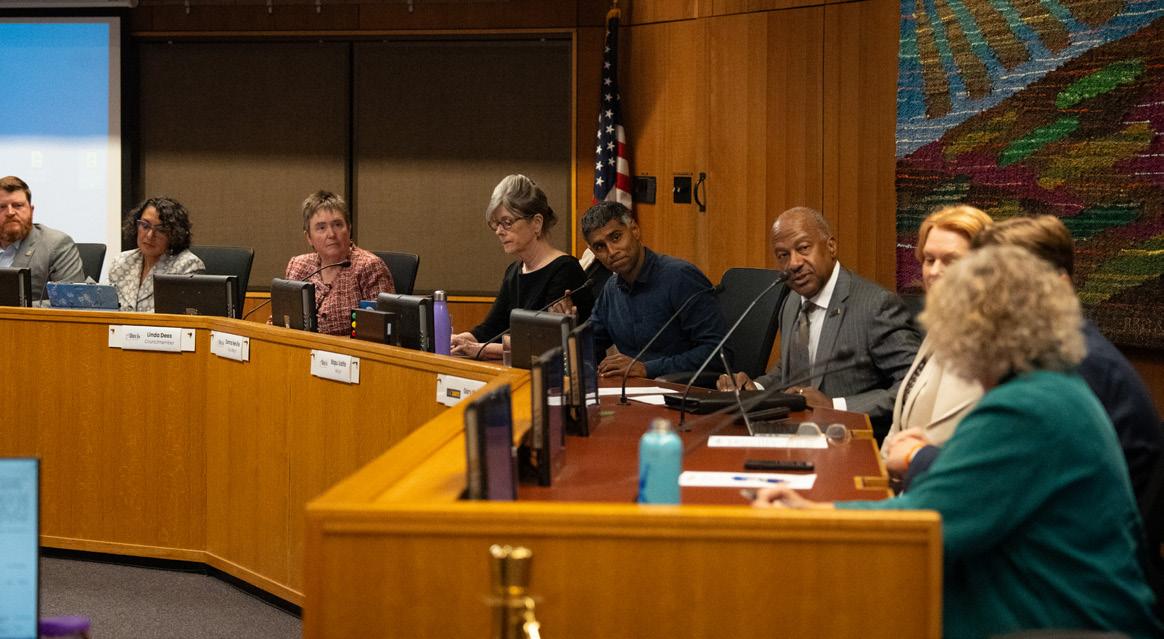
Sheehan pointed to funding and design choices that made lower prices possible.
“[Tese two properties] were both funded with tax-exempt bond funding because we partnered with a nonproft,” Sheehan said. “We designed them very efciently with an ofsite, panelized system.” Representatives at the meeting then transitioned into discussing the Crisis Now program. Yolo County Administrative Officer Dirk Brazil introduced the program.
“In the past, most of our emergency response for mental health and substance abuse emergencies have been siloed, whether it’s police, fre, what have you,” Brazil said. “Tis in front of you now is a combined efort to get out of those silos and move in a more coordinated fashion.” Brazil said two components of Crisis Now, the 24/7 Access/Crisis High-Tech Call Center and the 24/7 Crisis Response and Co-Responders, have been put into place. Te third
component, a Receiving/Sobering Center, has still not been completed.
Of the $3 million needed to build the center, $850,000 will come out of federal funds earmarked by Congressman Mike Tompson. City Manager Mike Webb said the rest of the money will be supplied by the cities of Davis, Woodland and West Sacramento.
“Davis’ contribution for that, in terms of one-time dollars, is about $900,000 total,” Webb said. “I won’t speak to the status of Woodland or West Sacramento, but they’re going through a similar exercise.” T e meeting was opened up to public comment on the issue of Crisis Now.
Kimberly Mitchell, a Davis resident, submitted a policy brief with recommendations for how to improve the program. Her frst recommendation was to expand the hours and availability of co-responders.
2X2X2 on 9

After nearly three decades of working for the city of Davis, Webb will now serve the whole of Yolo County
BY OLIVIA HOKR city@theaggie.org
On Feb. 21, the city of Davis announced that City Manager Mike Webb accepted a new position as county administrator of Yolo County (CAO). Webb graduated from UC Davis with a degree in environmental policy analysis and planning and kick-started his career as a planning intern with the city. Since then, he worked his way into the roles of planning technician, assistant planner, associate planner and principal planner.
In 2013, he became the director of community development and sustainability. Webb served as the assistant city manager beginning in 2015, and just two years later, he was appointed city manager and held that position for eight years.
“After being with Davis for nearly three decades, it was certainly a big decision and one that I did not take lightly,” Webb said. “Te fact that the role was specifcally here in Yolo County was the single largest contributor to my decision to pursue it. I have forged so many partnerships and relationships countywide over the years — the opportunity to serve the broader Yolo community and continue to build upon those partnerships in new ways was one I could not pass up. I am very excited to serve Yolo County in my new capacity as CAO.”
The city manager is the chief executive ofcer of the city. Teir job is to provide administrative direction to various city departments, oversee the management of the city, coordinate the activities of the city’s departments and serve as the city’s primary representative to other government agencies and
private organizations. Te position of CAO is comparable to a city manager in terms of administrative leadership and executing policies.
Webb described some of the key aspects where the jobs difer.
Te diferences are in the scale and scope of those responsibilities,”
Webb said. “At the county level, you have a geographic area of over 1,000 square miles compared to about 10 square miles for the city. Te services at the county level are more expansive as well. While counties provide a very similar level of government services and infrastructure to the rural areas as cities, counties also deliver a whole suite of additional services and programs county-wide, including health and human services, agriculture, assessor/ clerk-recorder/elections, libraries, law and justice, airports, landfll and environmental health, to name a few.”
During Webb’s time as city manager, he accomplished a variety of projects that benefted the community. Te city’s press release shared a list with a few of his major achievements.
“[Webb] led the team to oversee the entitlement and development of a multitude of commercial and residential projects,” the press release reads. “[Tis included] thousands of market rate and dedicated afordable housing units and new neighborhoods, and commercial projects such as DMG Mori, University Research Park and Target, to name just a few.”
Davis’ mayor, vice mayor and councilmembers all expressed admiration and appreciation for Webb’s commitment to the community. Donna Neville, the current vice mayor and city council member for district three, was among those commending Webb’s work.
“Mike Webb has been an exemplary city manager,” Neville said in the press release. “His depth of knowledge, his long history with the City of Davis and his strong but compassionate management style have all served the City well. We will miss him greatly, but [we] look forward to seeing him excel in this new position.”
Josh Chapman, the councilmember representing district fve and former mayor, shared similar sentiments.
“City Manager Webb has been a dedicated employee and leader for the City of Davis with resilience and fortitude,” Chapman said in the press release. “We appreciate his years of service and wish him all the best in his new role as County Administrator for Yolo County.”
Kelly Stachowicz has served as assistant city manager since 2015. Efective March 31, Stachowicz will take on the position of interim city manager while the city council searches for a permanent replacement. Webb will begin his new position with the county on March 31, 2025. He shared some fnal regards to his colleagues and his city.
“While I am very excited about my new role and what I will bring to the Yolo team, I will dearly miss my Davis colleagues, many of whom I have worked with for decades,” Webb said. “Our Davis staf team is truly fantastic, and the community is fortunate to have them working for the good of Davis each and every day. Davis is also fortunate to have a city council who cares deeply for the community and the organization. While I will miss the people dearly, I am not going far, and I look forward to working with them in my new capacity.”
The meeting set out to discuss recent hate incidents in Davis
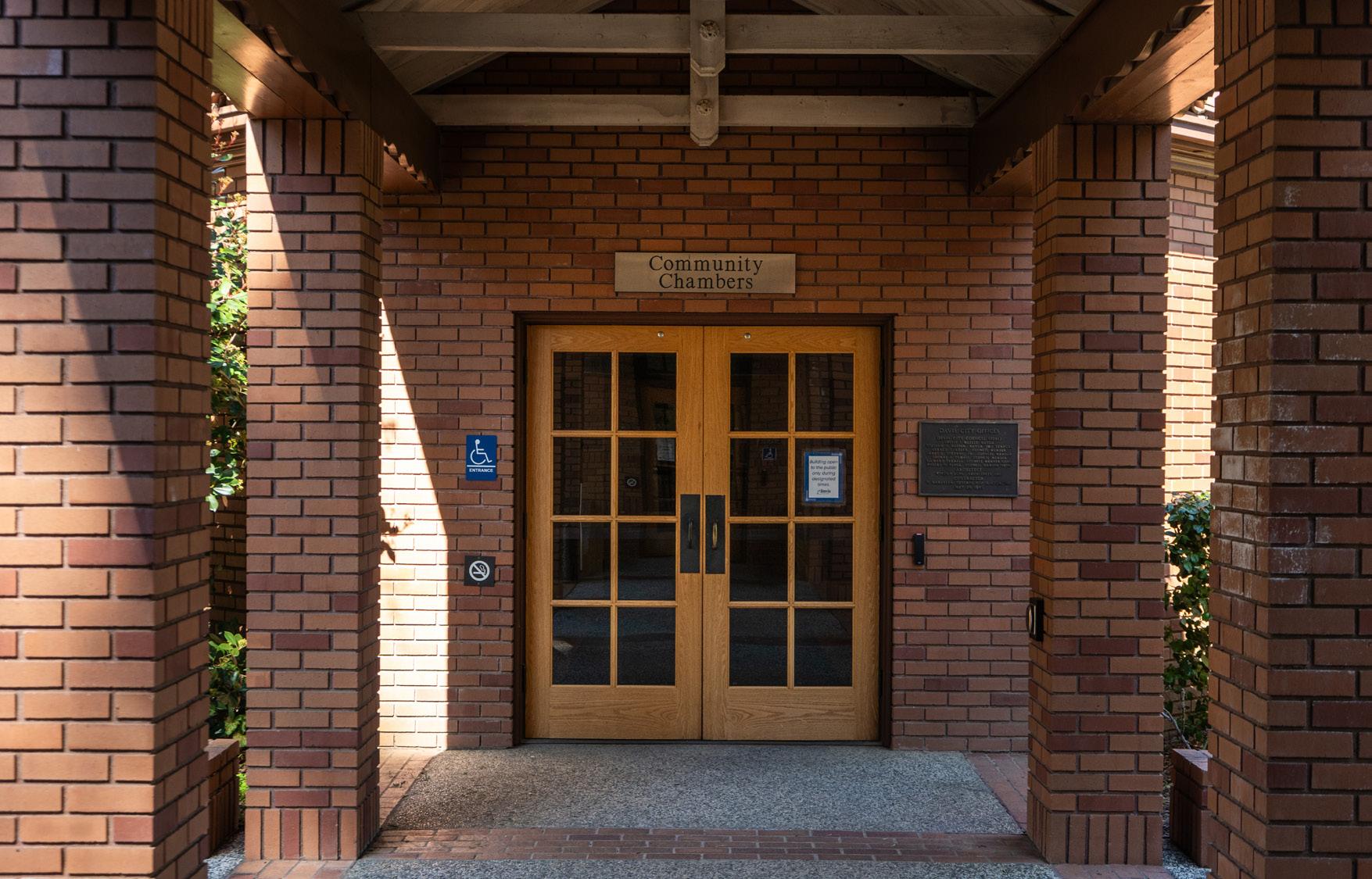
BY YUENJO FAN city@theaggie.org
On Feb. 27, the city of Davis Human Relations Commission (HRC) met to discuss sanctuary city policies and address issues of hate alongside a recent controversy between two commission members. Te controversy came after HRC Commission Member Amir Kol criticised fellow Commission Member
Deema Tamimi at a recent city council meeting for supporting a book titled “Tey Called Me a Lioness: A Palestinian Girl’s Fight for Freedom.” Kol claimed that the author had voiced past antisemitic remarks while Tamimi maintained the book’s exposure of injustices toward the Palestinian people.
With the HRC already planning to address issues of hate and discrimination, this subject matter became one of the main focal points of the meeting. Tamimi provided comments backing up her stance while Kol opted to forgo any personal statements during the meeting.
“It made me sad to see that new fears and divisiveness is being sewn right in this place where we are hoping to alleviate fear and not stir up and create new fear,” Tamimi said. “I shared this book and her story, in part because I believe people need to gain a better understanding of the everyday struggles of Palestinians, but also because we are in a time of great turmoil. Here in our local communities where our rights and the rights of our neighbors, family and friends are under attack, we have a duty to speak up to protect the most vulnerable in our communities.”
Furthermore, many meeting attendees chose to voice their opinions and concerns through the public comment section of the meeting. With an audience that was larger than usual, comments ranged from an overwhelming backing of Tamimi to support for Kol, alongside public concerns for people’s ability to express themselves.
Dean Johansson, a Davis resident of over 30 years, warned of the “heckler’s
veto,” a situation where people become silenced due to intimidation of being in the minority. Johansson voiced how public gatherings such as the HRC meetings must avoid this situation and allow people to exercise their freedom of speech, regardless of belief.
“We’re taught freedom of speech and frst amendment rights are the bedrock of democracy, [but] the heckler’s veto is exactly what I’ve seen going on here in Davis over and over again,” Johansson said.
Public comments also went as far as suggesting that the HRC should evaluate potential consequences to Kol for his criticism toward Tamimi.
UC Davis faculty member Catherine Brinkley voiced her concern for the incident, believing that Kol’s comments were harmful to both the community and the HRC.
“I hope that the Human Relations Commission carefully considers protocols for when there are interpersonal conficts so that they are not unduly escalated,” Brinkley said.
“[Tere are] vulnerable student voices who have come out and said that they felt personally, physically and verbally threatened, and that is problematic to have on the Human Relations Commission.”
With so many diferent opinions swirling around, Commission Member Edgar Wong-Chen acted as a mediator, balancing the dispute between Kol and Tamimi.
“As members, we have to be able to stand up for what we advocate for, obviously, but we also have to respect the process and the collegiality of all of us being here,” Wong-Chen said.
“We have to respect that everybody’s voice matters and that we each have an opportunity to state what bothers us, but also respect the other person’s ability to sit in their seat and speak theirs.”
Wong-Chen further addressed a recurring notion brought up by public comments to potentially remove Kol from his position.
“In my opinion, asking someone to be removed from the commission is not productive,” Wong-Chen said.
“So I hope we can move forward, and I

The meeting had discussions of temporary and conditional use permits BY PIPER AWEEKA city@theaggie.org
On Feb. 26, at 7 p.m., the city of Davis Planning Commission held its bimonthly meeting at the Community Chambers to discuss two scheduled public hearings.
In the frst hearing, the Co-Chair of the Interfaith Housing Justice Davis, Ellen Kolarik, advocated for the commission’s acknowledgment of her organization’s equitable housing development initiative.
“Our approach is principle-based,” Kolarik said. “We strive to shape a future where housing is accessible, sustainable and just for all members of our community.”
Thomas McNairn, an associate planner for the city of Davis, introduced the frst of the two public hearings of the evening: a proposed conditional use permit (CUP) at a multi-tenant warehouse.
hope we can build a bridge, and I hope we can continue a dialogue. [...] If we can’t exist here together, then the HRC shouldn’t be here.”
Following these discussions, Kol brought forth updates on arrangements to host a Jewish American Heritage Month celebration in May. The objective of this event is to bring a sense of community to Jewish Americans living in Davis in light of concerns about antisemitism.
“We decided that a very appropriate theme would be Immigration, Resilience and Solidarity: Te Jewish American Journey and Beyond,” Kol said. “We’re thinking about a community picnic in Central Park where people come together and bring food [alongside] some music and dancing.”
Currently, the event is being targeted for May 31 and is seeking an endorsement from the HRC before moving to the city council for approval.
Moreover, the HRC also expressed an increased concern for protecting Davis’ immigrant community.
Following the city’s frst Immigration and Customs Enforcement arrest, the HRC now seeks to fnd ways of strengthening Davis’ sanctuary city status. Commission Member Felix Alvarez proposed adding Davis to the Welcoming Cities network, a nonproft organization that allocates further resources to assist immigrants.
“We talked about Welcoming Cities and whether this is something that the city of Davis should explore,” Alvarez said. “It’s an addition to the sanctuary city marker but comes with some more added benefts. It would be a membership that the city would have to look into and employ but it also comes with resources from the non-proft to the city. Tis would help us create programs to provide further assistance for those communities.”
T e HRC meets on the fourth Tursday of each month in Community Chambers at the City Hall, and more information can be found on the city of Davis’ website.
T e proposed uses within this space are primarily a climbing gym and a bouldering gym,” McNairn said.
T e space will also o f er climbing areas for kids, cardio and weight training activities, as well as a snack bar with items available for purchase for members. Staf fnds that the proposed use is compliant with the zoning and compliant with the surrounding uses.
[...] We recommend that the Planning Commission approve of the resolution that will allow the bouldering feld.” With similar statements from her colleagues, Commission Member Georgina Valencia stated her acceptance and approval of the proposed CUP.
“I think the economics of having another business in our community is a good one,” Valencia said. “Something that’s orientated around health and ftness seems good also.”
After a unanimous vote approving the CUP, the commission went on to address the other item of concern.
The second public hearing was dedicated to 1123 Olive Dr., where two food trailers have been operating as accessories to Davis’ Volt Cofee shop. McNairn shared that because the prior temporary use permit (TUP) had expired as of February, the applicant has applied for an additional TUP and CUP.
In his coverage of the proposal, McNairn stated the lack of Volt’s compliance with the terms of their past TUP and CUP, one concern being an expired health permit for one of the
operating food trucks.
“A temporary use permit is arguable that it can turn into a property right and so out of an abundance of caution, [the] staf is recommending that you revoke the temporary use permit,” McNairn said. “Based on the non-compliance of the temporary use permit, [staf] cannot recommend that the Planning Commission approve of the conditional use permit. Sta f recommends that the Planning Commission revoke the temporary use permit for the two trailers [...] and also deny the conditional use permit for those two trailers, as well.” Robert Salazar, the applicant and one of the owners of Volt, voiced his perspective.
“Like any new business, we had a learning curve during the frst 12 months of operations,” Salazar said. “We believe we’ve remedied all the situations and issues. [...] We respectfully request an extension or approval to get this fnalized and past us so we can focus on Volt. We’re not perfect, we’re new to this.”
Following the Planning Commission’s discussion of Volt, the meeting allowed public comment on the issue. After a slew of supportive testimonies from contractors and employees at Volt, commissioners deliberated on the conditions in which the approval of the permits could be granted. With no clear consensus being agreed upon, Commission Member Vince McLaughlin stated his motion for a two-week extension of the hearing.
“I don’t want to wait six months for this,” McLaughlin said. “I was thinking of something like 30 days to sign the development agreement, 120 days to complete the work unless there are delays attributable to city processing, then the TUP would be revoked and the CUP would be denied. I’m inclined to vote in favor of rolling it over to [the] next meeting to see if they can make a concrete proposal. [...] I move to continue this matter until our next planning commission meeting for further direction from staf and deliberation by the commission.”
With all commission members voting in favor of McLaughlin’s motion, deliberation on the 1123 Olive Dr. proposal will continue at the next Planning Commission meeting on March 12. More information on the Planning Commission and future meetings can be found on the city of Davis’ website.
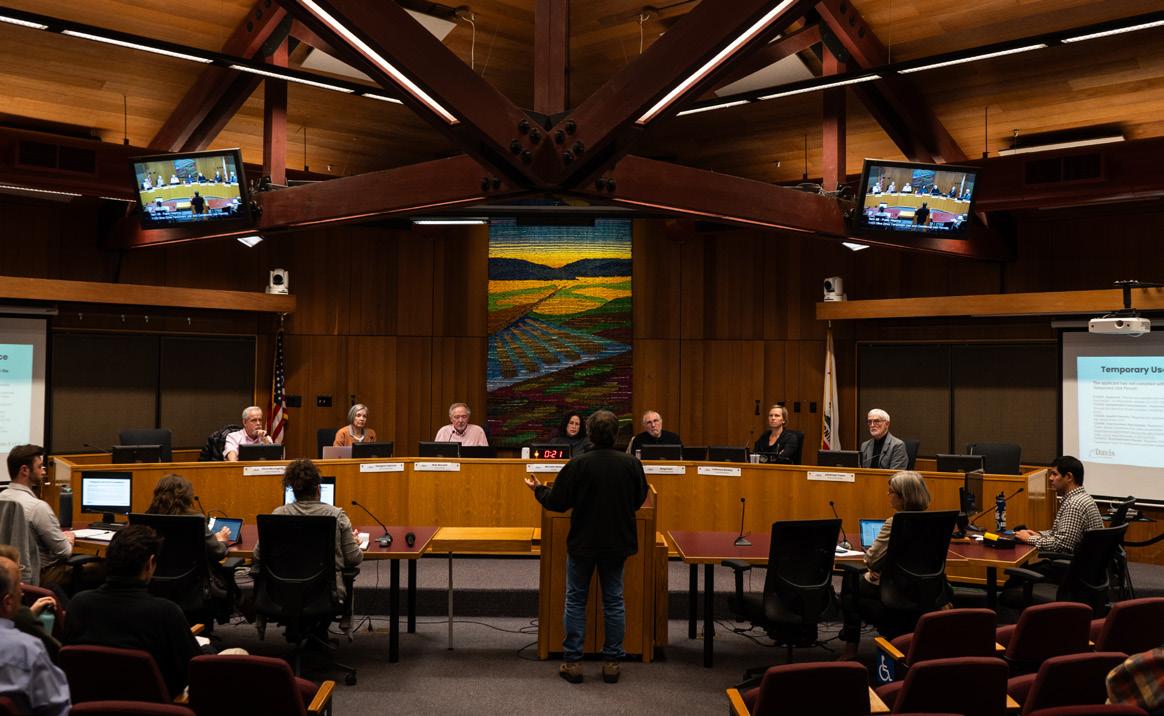
The student government voted in private, approving legislature to boycott Israel academically and fiscally; LSA member discusses campus administration response
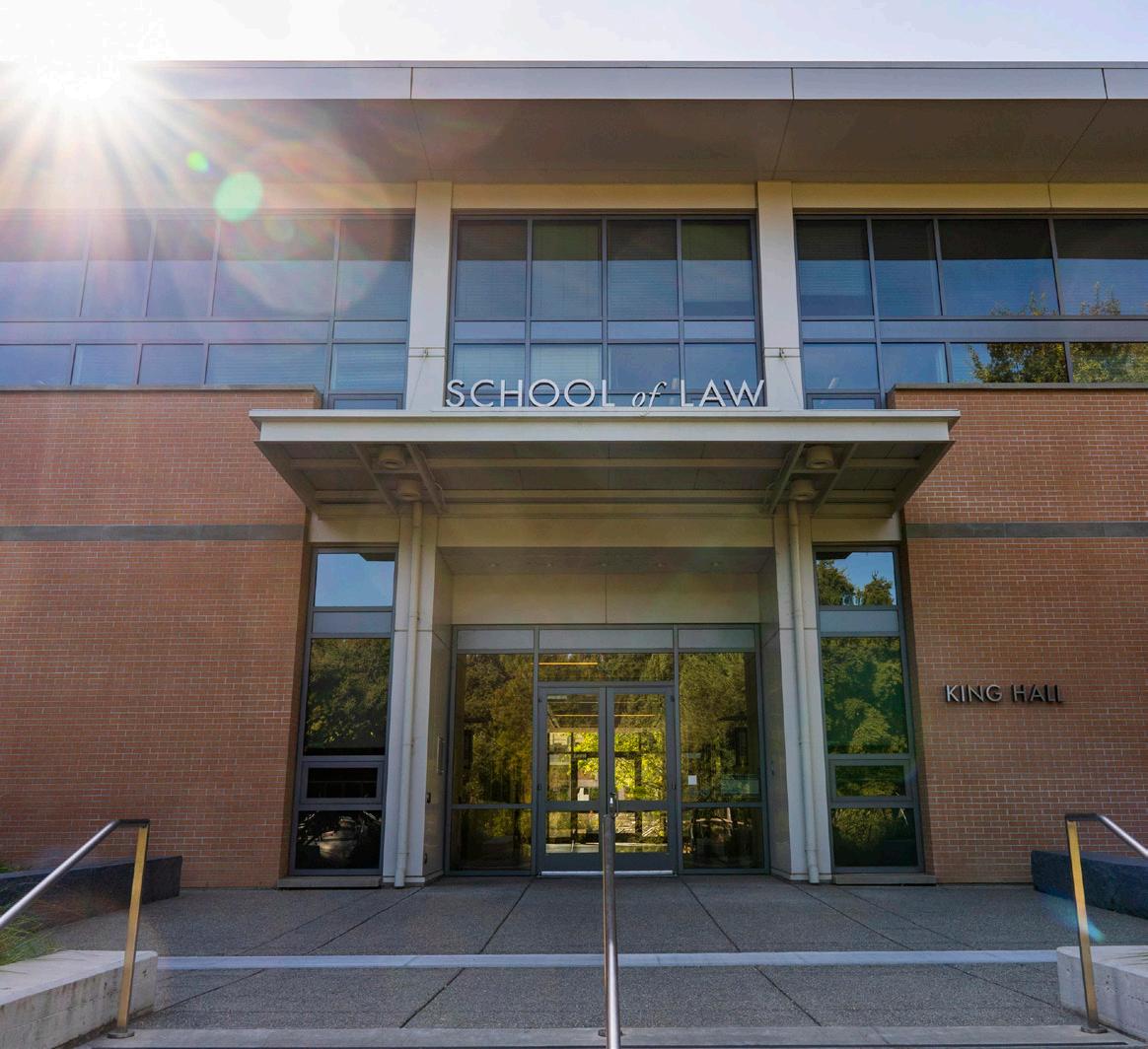
BY RIVERS STOUT campus@theaggie.org
On Feb. 28, the Law Student Association (LSA) at King Hall voted on Boycott, Divest and Sanctions (BDS) legislature written by the National Lawyers Guild (NLG) at UC Davis. Tey voted on the legislation without public notice in order to protect voters from future discrimination, and the constitutional amendment passed. Te amendment seeks to boycott Israel in primarily two ways: academically and fscally.
“[Te] LSA will not approve the use of student funds for businesses listed on the BDS list as prioritized by the US Campaign for Palestinian Rights,” the bill states.
Another segment of the bill clarifes the boycotts that the amendment details.
“[The] LSA will not approve funding requests for events with speakers who represent the Israeli government, regardless of their nationality, religion, ethnic origin or voluntarily represent Israeli academic institutions that are complicit in occupation and genocide, including Technion Israel Institute of Technology, Tel Aviv University, Hebrew University of Jerusalem and Haifa University. Tis constitutes the UC Davis School of Law Priority Academic Boycott List (Academic Priority List),” the bill states.
Shasun Sulur, a second-year graduate student in the UC Davis School of Law and member of the NLG and the external vice president of the LSA, expanded upon the academic boycott.
“Not only did it state that we shouldn’t be spending money on corporations [on the BDS list], but also that we shouldn’t spend money to sponsor speakers that voluntarily work with Israeli academic institutions that perpetuate the genocide,” Sulur said. “So, for speakers that are pro-Zionism or pro-genocide, we should not be
spending out student fees to support them. Tis doesn’t mean that student groups can’t still invite these speakers to campus — that these events can’t happen — but we as a collective should not be spending money to bring these speakers to campus.”
Sulur stated that the LSA controls between $30,000 to $50,000 in a given year, according to the treasurer’s fnances. Te amount that went to companies, which the LSA will now boycott, is unknown.
“What we saw last year in response to student protests and student voices against the genocide in Palestine/Gaza was retribution from many law frms out there [by] revoking offers and taking away student’s fnancial freedoms through revoking job ofers,” Sulur said.
Te LSA will also boycott law frms which they believe have expressed refusal to hire those who have advocated for Palestine. Sulur said he believes that the UC Davis School of Law has been selectively enforcing rules when it comes to the NLG and its activism for Palestine.
“We have experienced some hostility towards our organizing around divestment in support of Palestinians,” Sulur said. “In holding certain events, we’ve been told after the event has happened that we’ve been in violation of certain policies, even though other student groups have not been held accountable to those same policies for holding similar events. We’ve had banners taken down, even though other student organizations have been allowed to put up banners. We’ve been told that we’re not allowed to post signage, even though other student organizations are allowed, or have not been reprimanded in similar ways.”
When asked if he believes the legislation opens the door for other boycott movements, Sulur stated he did not wish to speculate, but said he hopes that organizing groups will continue to boycott settler colonial states. Similarly, the NLG does not have plans to organize in support of other countries as it has with Palestine.
Te amendment’s purpose and the policies it implements resemble many aspects of SB #52, the ASUCD Senate Bill which enabled and mandated the ASUCD to boycott Israel and other organizations complicit in the “human rights violations against Palestinians amidst the ongoing genocide in Gaza,” as well as established the creation of the Ethical Spending Committee.
“[Te amendment] was extremely infuenced by [SB #52],” Sulur said. “Many of us [that] were involved in writing the legislation were at the pivotal vote [...] gave public comment, and some folks involved in writing this legislation spoke extensively with members of the ASUCD, talking about what implementing the legislation looks like with administration and what the Ethical Spending Committee’s role is in making sure that the language of the bill is followed and follows [University of California] (UC) policy, [as well as] any roadblocks faced in implementation right now with administration and the pushback that they’ve received.”
Sulur described the administration’s response to the LSA’s amendment.
“We received notification on Monday that administration, more specifically Campus Counsel and Associate Vice Chancellor for Student Life, Campus Community and Retention Services Sheri Atkinson, does not believe that this constitutional amendment is in line with campus policy,” Sulur said.
“Specifcally, their policy regarding their contracts and business agreements. [...] I don’t want to speak on specifcally what they found in violation further, because though we democratically as an LSA board passed this constitutional amendment, we have received no clear notice, no clear direction and no clear communication from administration as to why this policy was against their guidelines.”
Sulur went on to describe that the administration has only reached out to the LSA’s president and what they took issue with.
“Tey told them that if we don’t repeal this legislation itself, then administration will take action against the LSA, possibly including dissolving our organization as it is,” Sulur said. “At NLG we view this as a scare tactic, and we’re demanding from the university that if they’re going to threaten to dissolve our student government, they give us a notice, a hearing [and] a fair chance to understand what their gripes are to work with them. Instead, they’re demanding we repeal this legislation itself, but that’s hearsay because they’ve not spoken to us. Currently on the agenda is a vote next Tursday to repeal this legislation.”
After reaching out to Atkinson, Te California Aggie was directed to Bill Kisliuk of Strategic Communications, who provided a comment on the matter.
Te Division of Student Afairs works closely with student governments, such as ASUCD and LSA, to support their efforts and provide guidance when requested,” Kisliuk said via email.
LSAAMENDMENT on 9
Moov-in’ Moo-seum, in collaboration with Aggie Arts, Unitrans and Secret Spot, hosted an event for students to make hanging art for the buses
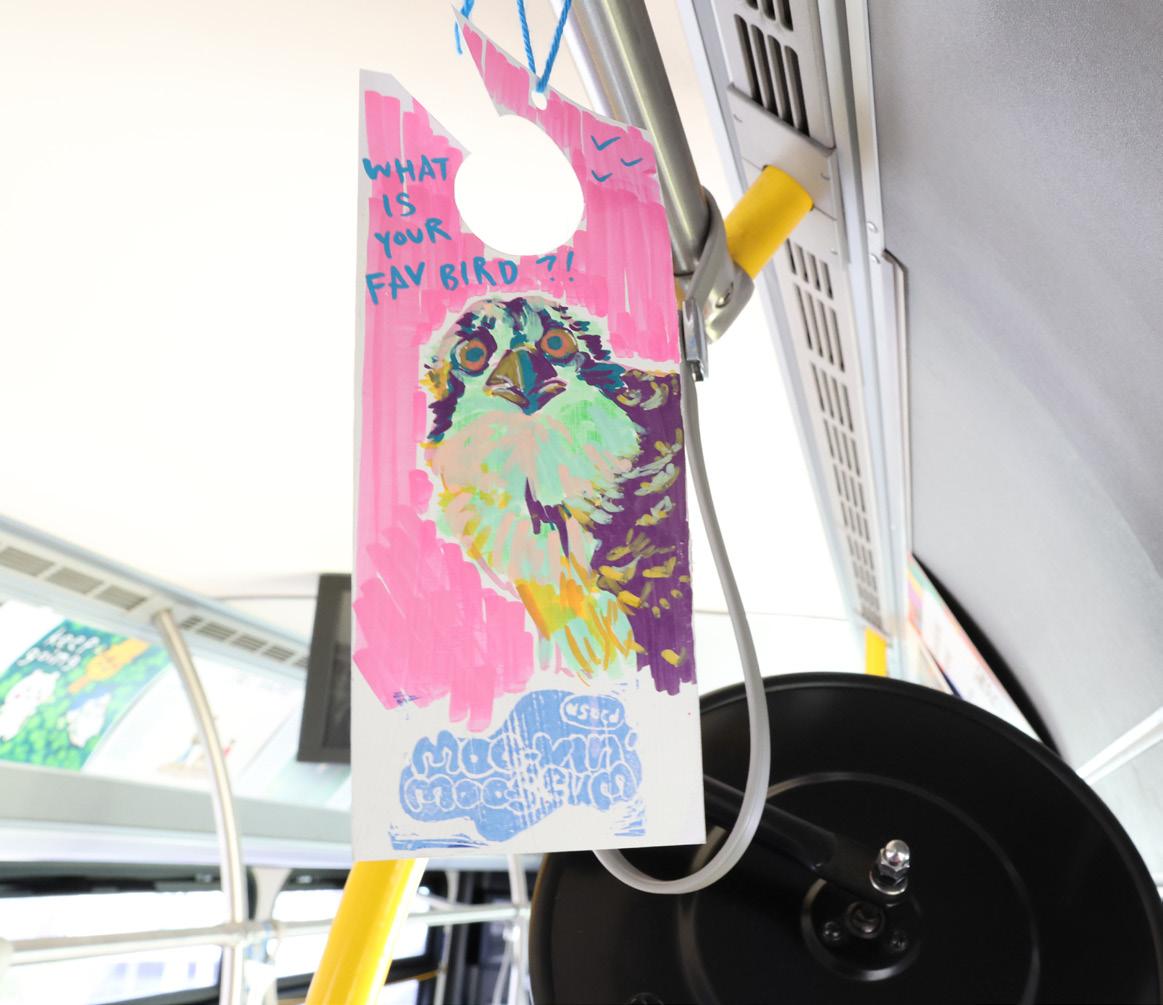
BY MEGAN PUSL campus@theaggie.org
A museum on wheels? At UC Davis, that means student art, buses and a tribute to our favorite animal, the cow. On Saturday, March 3, the Moov-in’ Moo-seum made its way into Downtown Davis for an art event at local art lounge Secret Spot.
Te ASUCD Moov-in’ Moo-seum is a new art program that brings art to public transit at UC Davis. Te program is a collaboration between Unitrans, Creative Media and Aggie Arts.
Jonah Messinger, a third-year food science major and project director for the ASUCD Moov-in’ Moo-seum, shared his excitement about the program. Te new art program is bringing art to public transit in Davis,” Messinger said. “We started with the Moo-seum bus, which is the wrapped colorful bus, [and] instead of ads, there is art inside the bus.”
On March 3, students gathered at Secret Spot to create their own artwork to be displayed inside all Unitrans buses. In the backyard of Secret Spot, students painted the art hangers while others performed in the open jam session.
Messinger explained what the event is all about as it turns everyday bus rides into mini art galleries.
“[Te art hangers] are going to go inside all of the buses in Unitrans,” Messinger said. “Tey hang from the handrails and are going to start popping up in all the buses. Today we have art supplies and blank hangers so people can create these, and we are going to install [them] throughout all the buses.”
Secret Spot, located at 117 D St. in Downtown Davis, acted as the venue for this art event. Te lounge has showcased over 100 diferent local artists and hosts a variety of classes and events at their location.
Toni Rizzo, co-owner of Secret Spot, explained how this collaboration came to be.
“[Moov-in’ Moo-seum] reached out
to us on Instagram, basically looking for venues for this awesome project that they are doing, and it kinda seemed like the perfect ft,” Rizzo said. “We are an arts and music lounge and this is the type of stuf that we do.”
Aggie Arts Committee Co-Chair Siomara Sanchez, spoke of the joy that the Moov-in’ Moo-seum brings to the community and said that she wants to continue to spread that creative spirit through public transportation.
“It’s been really great having the opportunity to involve the community as a whole through the Moo-vin’ Mooseum,” Sanchez said. “We are trying diferent ways to engage with the city and the students, and seeing the results has been really exciting. Tis initial launch year has let us get a good idea on what’s been working and what hasn’t. We are really excited to keep bringing art to everyone in diferent ways while hopefully making public transport more fun.”
Messinger expressed that he hoped the Moov-in’ Moo-seum art event would get students involved with the art program on campus and introduce students to places like Secret Spot.
“The idea with these hangers is it brightens people’s commutes,” Messinger said. “With this event in particular, I hope it brings people together and forces [people] to recognize a lot of the art spaces that exist here in Davis.”
Anyone can ride the Unitrans Moov-in’ Moo-seum bus around Davis, as it operates on standard Unitrans bus routes. Keep an eye out for the vibrant exterior as it cruises through Davis to transport students to campus, downtown and beyond. The next Moov-in’ Moo-seum project on Unitrans buses will be a collage of student memories in Davis. Anyone who has memories, past or present, in Davis is encouraged to submit photos that will be displayed inside of the buses. Visit the Moov-in’ Moo-seum website to submit photos by March 21.
The event introduced students to resources such as CalFresh, amongst other social services
BY JESSICA YUNG campus@theaggie.org
From. Feb. 24 to 28, the Aggie Compass Basic Needs Center held a series of events known as CalFresh Outreach Week. Tese events included a pizza and drinks social, an informational day at their center and the LGBTQIA Resource Center, a meal at the Aggie Eats food truck and a “Pickling 101” workshop.
Te Peer Navigators at the Aggie Compass Basic Needs Center, including Lisa Pan, a second-year clinical nutrition major, Lorena Alvarez Flores, a secondyear political science — public service major, Dylan Jang, a fourth-year food science major, and Myo Maung, a fourth-year communications major, described the event as a way to ensure that students know what services are available to them.
“Outreach Week is a time when Aggie Compass focuses on making sure students know about the resources available to support them,” the peer navigators said. “A big part of the week highlights CalFresh and how students can access food assistance. It’s also an opportunity to spread awareness about the Basic Needs Center as a whole. Many students don’t realize the range of support we ofer [from] food and housing assistance to f nancial and wellness resources.”
On their website, Aggie Compass provides information and access to students about the various resources they provide. It also states their mission and goal for the community.
“Te Aggie Compass Basic Needs Center helps by providing access to
nutritious food, assistance applying for CalFresh and other social services, access to economic crisis resources, case management and immediate shelter and support for unhoused students,” the website reads.
Te peer navigators, whose role is to support students at Aggie Compass, elaborated on the assistance that the Aggie Compass Basic Needs Center provides.
“Aggie Compass Basic Needs Center is here to make sure students have the support they need to be successful at UC Davis,” the peer navigators said.
“We help students access essential resources like food, housing, fnancial assistance and wellness support — because we shouldn’t have to choose between education and meeting our basic needs.”
One way that Aggie Compass Basic Needs Center can help students, and the main promotion of the week, is through CalFresh.
“CalFresh, also known as SNAP/ EBT, is a long-term food assistance program for low-income people who meet federal income eligibility rules and want to add to their budget to put healthy and nutritious food on the table,” the website reads.
Te peer navigators explained more of what CalFresh ofers.
“CalFresh is a federally funded nutrition program that helps students aford groceries by providing up to $292 per month in food benefts,” the peer navigators said. “It’s designed to support those with fnancial need, making it easier to access nutritious meals. For many students, CalFresh can be a crucial resource in reducing food insecurity and ensuring they have the energy to focus
on their education.”
Many students use CalFresh to supplement their funds while they learn at UC Davis. Saul Duran, a fourthyear computer science major, said that CalFresh helps students in need.
“It’s important that programs like CalFresh are a thing since it helps many students in need who otherwise wouldn’t be able to eat,” Duran said.
Lola Jung, a fourth-year art studio major, said that CalFresh has been a lifesaver for her.
“I’m an undergrad myself, [and CalFresh] is, no exaggeration, a lifesaver,” Jung said. “With so little time to work and make money while being a student, it would actually be impossible to eat properly, let alone healthily [without CalFresh].”
Afording both food and housing costs has been a worsening problem for university students everywhere, and particularly in California, according to World Population Review.
“California has the nation’s third-highest cost of living index at 142.2,” the website reads. “California’s transportation costs are the secondhighest in the country, due in part to high gas prices in the State. Housing in California is twice the national average, with a typical single-family home priced at $683,996.”
Leslie Kemp, the director of UC Davis Basic Needs Initiative and Aggie Compass Basic Needs Center, stated that change is occurring to help students with these issues.
“Students shouldn’t have to skip meals or choose between rent and food just to get an education,” Kemp said. “CalFresh provides crucial, ongoing support, but we know that
not every student qualifes and the student exemption rules and citizenship requirements leave a lot without access to healthy food.”
Kemp continued by describing other alternative resources to CalFresh.
“That’s why we’ve developed solutions like our county-approved Local Programs for Increased Eligibility (LPIE), which helps students qualify for CalFresh when they don’t meet the work [or] work training requirement,” Kemp said. “For those who are ineligible due to other student exemption rules, we created AggieFresh — a pilot program that provides the same level of monthly food support as CalFresh to students who would otherwise qualify.”
Te peer navigators described how students can interact with their services. “Students can access our services in whatever way works best for them — they can email us (compass@ucdavis. edu), give us a call [at] (530) 752-9254 or stop by Aggie Compass in person at the [Memorial Union], no appointment necessary, just walk in and let us know what kind of support you’re looking for,” the peer navigators said. “We can provide direct assistance or connect you with other campus and community resources. Depending on the service, you may need to show your student ID, fll out a quick form or sign a document, but we can help.”

Have all of the stories already been told?
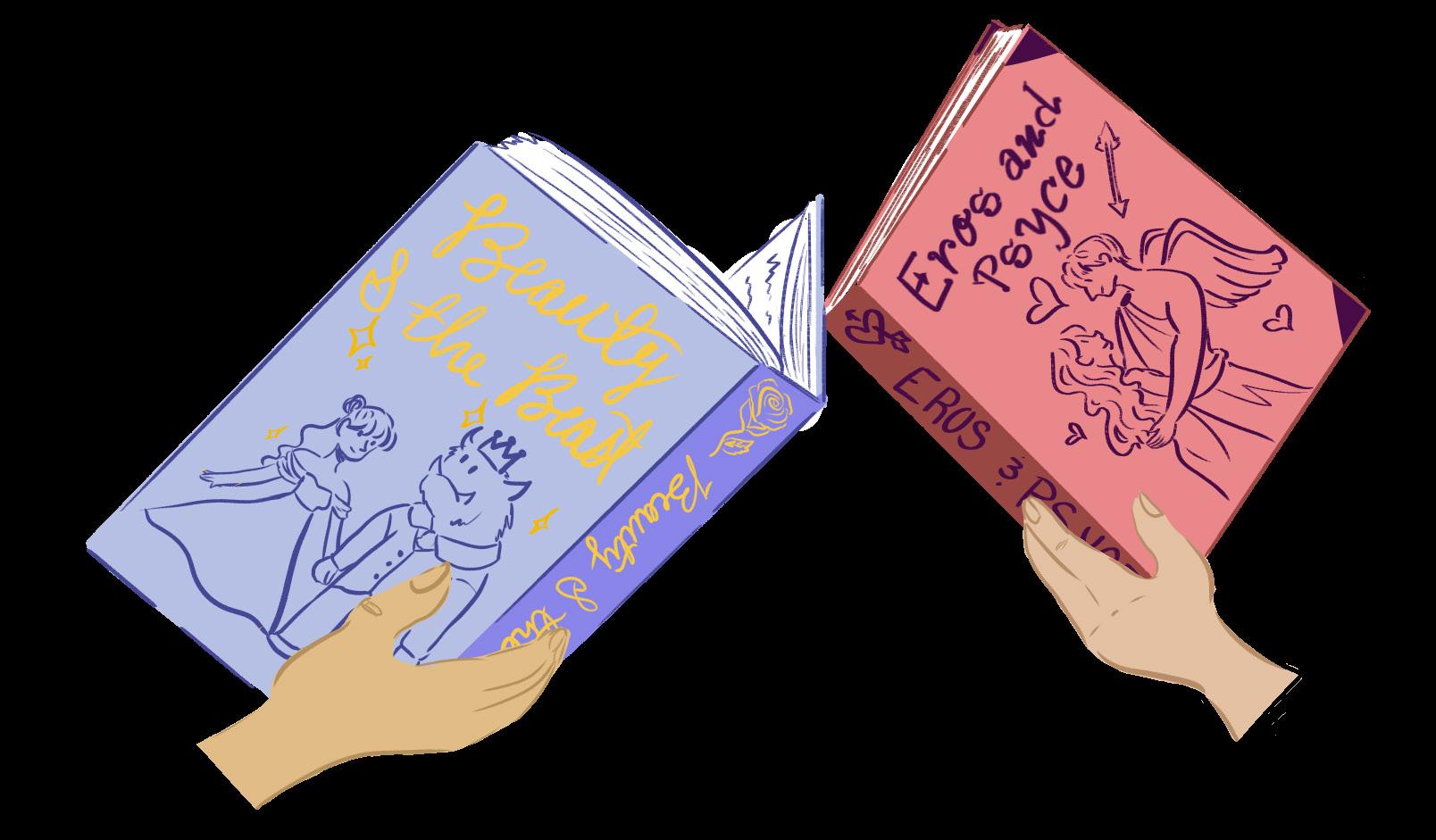
BY MOLLY THOMPSON mmtthompson@ucdavis.edu
On the surface, our modern media landscape might seem like it’s full of new ideas and fresh stories. But in reality, we’re essentially rehashing the same classic themes time and time again, with the occasional twist.
Tere’s a theory in the world of literature initially coined by Melanie Anne Philips and Chris Huntley, which posits that there are only seven basic plots all stories can be traced back to. Essentially, every story is based on the same set of frameworks. Whether or not it’s actually true is arguable; In a way, these frameworks are sort of analogous to horoscopes or personality tests — if you look hard enough, you can probably fnd what you’re looking for. But, for the sake of the theory, here are the basic plots.
Te frst is titled “Overcoming the Monster,” where the hero must brave the lair of an anti-hero that’s threatening them and their community, defeat it and return victorious. Examples include everything from the classic “Beowulf” (the story of a hero who vanquishes the monster Grendle) to “Harry Potter and the Sorcerer’s Stone” (in which Harry overcomes the malicious Lord Voldemort).
The second, “Rags to Riches,” entails a down-on-their-luck protagonist overcoming the odds and reaching their full potential of greatness, in one way or another. Te obvious example of this is the ever-present “Cinderella” (which tells the story of a downtrodden maiden who rises to fame and fortune when she falls in love and marries a prince), but it can also be found in many other stories. Tis one is especially common in fairy tales — “Te Frog Prince” (in which a prince is cursed to remain as a frog until a good princess truly accepts him) is another good example and extends to the Disney movie based on the tale, Te Princess and the Frog,” as well. Next on the list, “Te Quest” tells of a hero who sets out on an obstacleridden journey to reach a great prize. Classically, “Te Odyssey” (Odysseus’ journey home after the Trojan War) is the poster child of this trope. However, modern examples can even include “Finding Nemo” (a fsh’s journey to bring his captured son home).
Fourth is “T e Voyage and the Return,” where a hero enters an unfamiliar and often enchanting new
world that becomes threatening, to the point that the hero must escape and return to the safety of their home. “Alice in Wonderland” (the story of a young girl who falls into a magical realm that she must fgure out how to escape from) showcases this, as does “Te Wizard of Oz” (also the story of a young girl who falls into a magical realm that she must fgure out how to escape from).
Te next trope is “Comedy,” which describes the tale of a community divided by the lack of self-awareness and selfshness, who eventually become united by love and the discovery of common ground. Shakespeare’s popular play “A Midsummer Night’s Dream” (the story of four Athenians running away to the forest and falling into a love triangle and other shenanigans) is a comedy, as is the 2001 flm “Bridget Jones’s Diary” (the story of a girl whose life upends when she becomes the center of a love triangle).
Fittingly, “Tragedy” is the subsequent plot framework. In a tragedy, the protagonist commits a fatal error and ends up falling from grace. Romeo and Juliet (two star-crossed lovers who end up dying as a result of their inability to live without each other, along with plenty of miscommunication) is a quintessential example of the tragedy trope. Te play “A Streetcar Named Desire” (about a woman who loses her grip on reality as she’s unable to get what she most desires) is also a good example.
Finally, the seventh plot is “Rebirth.” In one of these stories, the anti-hero holds the hero hostage until they can be freed by the living act of another character. Te ancient Greek story of Eros and Psyche (in which the goddess Aphrodite curses Psyche to fall in love with an unworthy man, but she ends up falling for Eros, who’s invisible the whole time) is exemplary of this trope. Te classic tale of “Beauty and the Beast” (in which Belle is trapped by the Beast, until she eventually falls in love with him and breaks his curse, allowing him to return to his human form) also follows the rebirth pattern.
Naturally, these tropes build on each other over time. “Cinderella” might be an example of the “Rags to Riches” trope, but it also provides its own base for future stories. Many flms (ie. “Ella Enchanted” or “A Cinderella Story”) are spin-ofs of “Cinderella” which is itself a spin-of of the “Rags to Riches” story.
REPETITIVETHEMES on 11
How state and local efforts to forcibly remove encampments and enforce Proposition 36 fail our unhoused communities
BY TARA ROMERO tcrome@ucdavis.edu
On July 26, 2024, California
Governor Gavin Newsom enacted Executive Order N-1-24, which allows and encourages local law enforcement to forcibly evict unhoused people from their encampments.
“It is imperative to act with urgency to address dangerous encampments, which subject unsheltered individuals living in them to extreme weather, fres, predatory and criminal activity, and widespread substance use, harming their health, safety, and well-being,” the executive order reads.
Newsom is quick to blame the “dangerous encampments.” Yet, all of the problems that he lists are not limited solely to encampments. As a result of limited resources and government aid, unhoused people are more vulnerable to extreme weather, fres, sexual and physical violence and the efects of addiction. Encampments are not to blame for California’s continuous neglect of unhoused people’s basic needs and human rights: What is to blame is state and local governments’ failure to properly allocate funding and resources to provide adequate food and shelter to our most vulnerable population.
Encampments can actually be a place for community among unhoused people who don’t have access to shelters. While homeless shelters do put in a lot of work to provide temporary housing to the unhoused community, many shelters have limited beds along with restrictions against people who have been incarcerated or those who use drugs. In spite of this, Newsom is cracking
BY NEVAEH KARRAKER nakarraker@ucdavis.edu
An empty wallet is something all college students carry. However, it may soon be possible to possess not just an empty wallet, but a negative wallet — a direct result of the wave of tarifs currently unfolding upon consumers who can least aford necessities.
For context, Mexico recently began specializing in the automotive industry rather than oil or energy. After supply chain disruptions caused by COVID-19, Mexico redirected its eforts to prioritize regional trade and nearshoring in order to amplify protectionism. In other words, seeking a supplier within close proximity to increase restrictions on imports and encourage a domestic industry. When the United States’ demand for the automotive industry surged, China’s lingering tarifs made it more costefcient for the U.S. to export auto parts to Mexico for assembly and then import them back into the U.S. to sell on the market.
This, combined with laborintensive, inexpensive “maquiladoras,” allowed Mexico to surpass China in 2023 as the top source of imports into the U.S., for the frst time in two decades.
Despite this positive economic growth, the U.S. remains in a serious debt crisis; In 2024 alone, there was a trade defcit of over $900 billion. As infation and the cost of living increase, the minimum wage remains insufcient to cover basic living expenses for most Americans.
As of March this year, President Donald Trump imposed 25% tarifs on steel production for Canada and Mexico, as well as increased tari f s from 10 to 20% on Chinese imports. In response, Mexico’s President Claudia Sheinbaum Pardo declared that the country will impose retaliatory tarifs. Canada and China have also vowed to strike back, sparking mass panic over a global trade war. Trump addressed these concerns by postponing the tarifs until April — for many, relief is deeply felt. In theory, tarifs could replenish domestic employment through increased wages and job opportunities. Tey could also generate revenue to assist in paying of debt via the redirection of currency and the encouragement of a competitive market.
However, tariffs can also lead
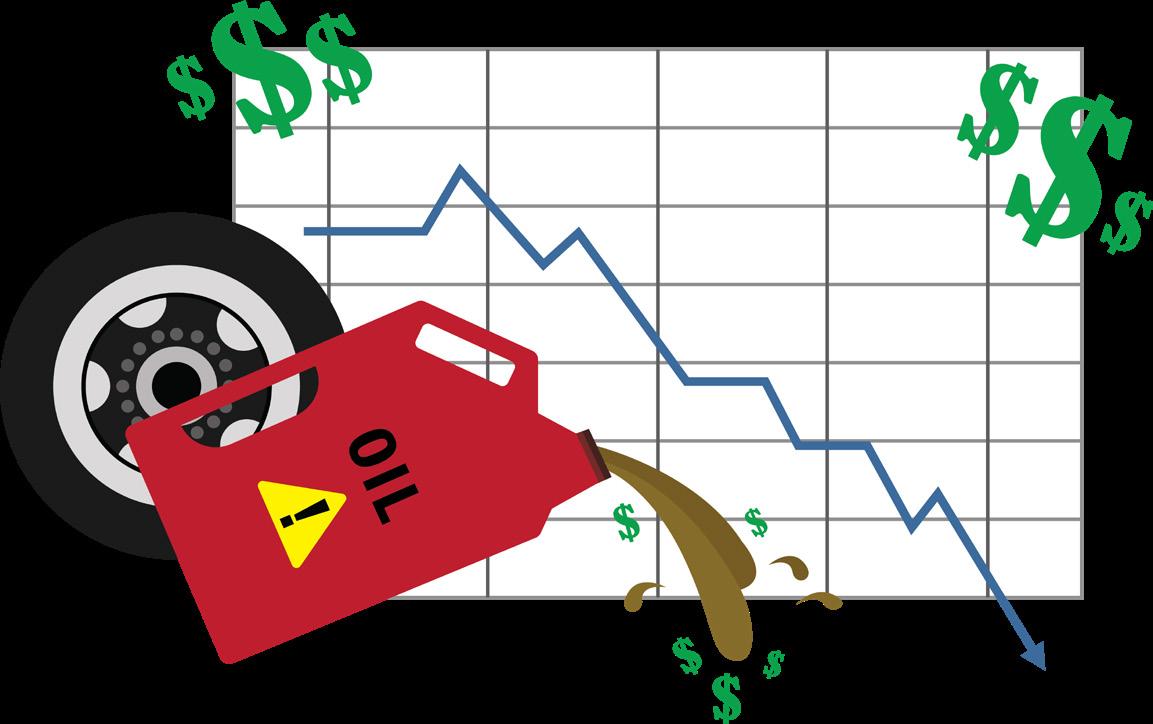
to high interest rates, supply chain disruptions and increased costs that ultimately burden consumers. Consumer prices have remained at an all-time high in recent years, due to factors like infation, the avian infuenza outbreak and subsidies related to climate change initiatives. Tese specifc tarifs instated by Trump will mostly infuence the cost of electronics, clothing and automobiles. An additional 10% tarif on Canadian energy imports will likely impact transportation, thus increasing food prices. Te U.S. is an industrial nation capable of being, to some extent, selfsufcient. Even so, the benefts of trade far outweigh remaining internally sufcient, as it provides opportunities for market specialization, global alliances and economic growth. Te ambition and desire to maximize proft and minimize labor costs frequently backfires by exceeding acceptable dependence on other countries.
Trump aspires to redirect focus on American industries, similar to the 35% tarif on Chinese tires instated in 2009 in order to improve American manufacturers’ profits and reduce job losses. He also hopes that these tarifs will coerce Canada and Mexico to enhance their dedication toward fentanyl trafcking intervention and illegal immigration prevention.
When cleaning your room, it generally becomes shockingly disorganized before it improves. Tis is the logic Trump is using to justify imposing tarifs on our closest trade partners, and it is clearly not entirely applicable to everything. While tarifs indirectly encourage consumers to invest in domestic businesses rather than foreign ones — which overall improves the economy — they also
provoke frustration and difculties for those already fnancially struggling.
Regardless of whether or not the long-term result of Trump’s actions will be benefcial via the elimination of trade imbalances and attraction of foreign direct investment, the immediate aftermath is concerning.
After the tarifs were instated, the stock market decreased by 2% and Dow Jones dropped 150 points. Now, investors fear a potential recession. Te impacts also extend beyond the U.S., as Mexico’s stable economic growth will largely be stunted. As a result, there could be ripple efects on the U.S., including a lower demand for American exports and job losses in sectors related to Mexico’s agricultural industries.
Further, the political tensions between all countries are expected to escalate, especially with Mexico given the present strains on border security. Te true impact of this decision remains uncertain — leaving consumers, as well as companies, holding their breath in anticipation.
In the meantime, instead of panicking, students can stay informed about updates and practice budgeting. Smart fnancial decisions, such as alternative transportation or shopping methods, might alleviate the consequences. Compared to a negative wallet, students may fnd that an empty one is a luxury.
Disclaimer: Te views and opinions expressed by individual columnists belong to the columnists alone and do not necessarily indicate the views and opinions held by Te California Aggie.
I’ve seen tabling from both sides now and they both suck A lose-lose college classic
BY MADISON SEEMAN meseeman@ucdavis.edu
T e sun was shining, the birds were chirping but, somehow, out of the nearly thousands of people who walked past where I was tabling, only a sympathetic few actually stopped to grab a sticker and stay for the spiel.
T ere are few constants in life: the sun, the moon and tabling college students. As long as college education exists, students will be found at foldable tables, trying to trap other students for one thing or another. It’s a campus classic!
Whether you’re freezing on the bench of a picnic table or zipping past very eager and borderline desperate faces, there’s not a single UC Davis student who hasn’t encountered tabling. And, if somehow you haven’t — what the hell? Please share your secrets.
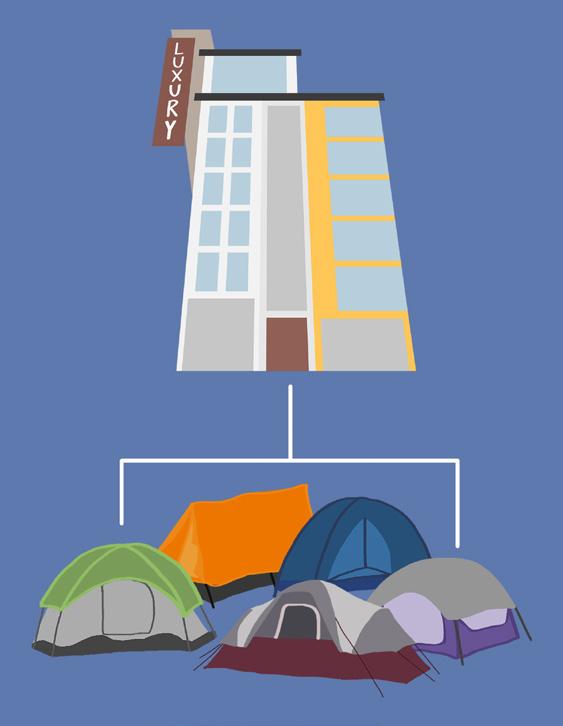
down on encampments. In opposition to Newsom’s order, Ann Oliva, chief executive ofcer of the National Alliance to End Homelessness, responded with her own statement: “ T e evidence is actually very clear: forced encampment evictions are inefective, expensive, and nonstrategic,” Olivia said in a press release.
A Research and Development (RAND) study in 2023 also revealed how encampment removal temporarily lowers the unhoused population in a given area for roughly two to three months but has no long-term efects. In August, Te Associated Press released a video of Newsom himself cleaning up a Los Angeles encampment. “I want to see results,” Newsom said in the video. “I don’t want to read about them. I don’t want to see the data. I want to see [change].” Newsom claims he wants to see results, but the truth is that he simply does not want to see unhoused people. Te act of removing encampments does
I’ve looked at tables from both sides now and I’ve only learned one thing: Everybody is sufering. Tis past year I have seen the worst of humanity — guerilla tactics from both sides of the table — and I’m here to give you the inside scoop.
Tey’re camped out at the Memorial Union (MU) and the Silo, just waiting to catch vulnerable students unawares. What do they want? It depends. Some tablers want new club members. Some want to raise awareness for real issues. Some want you to join them for some Korean BBQ, which comes with a secret side of Christian conversation.
Some tables trap you with an ambiguously designed banner. Others might lure you in with compliments: “Oh, I like your shirt and, hey, would you like to convert to my religion?” And don’t forget the stickers — props are everything. Maybe it’s my fault that I can’t say no to a good sticker, but hey, it’s a free sticker. And the wheel? You’re telling me I get to spin a wheel? I’ve seen people who get more joy from the wheel than the prizes on it.
But there are also expert tableavoidant targets that have perfected the slippery art of table-based subterfuge.
not actually solve the problem, it only moves unhoused people out of the public sight. In other words, Newsom does not care whether unhoused people actually get of the streets — he cares that it looks as if they did.
On Feb. 24, 2025, Newsom announced that he would begin holding local governments accountable for their use of state funding for the homeless — by threatening to withhold funding to increase pressure on local ofcials to remove encampments. Now, mayors across the state, from
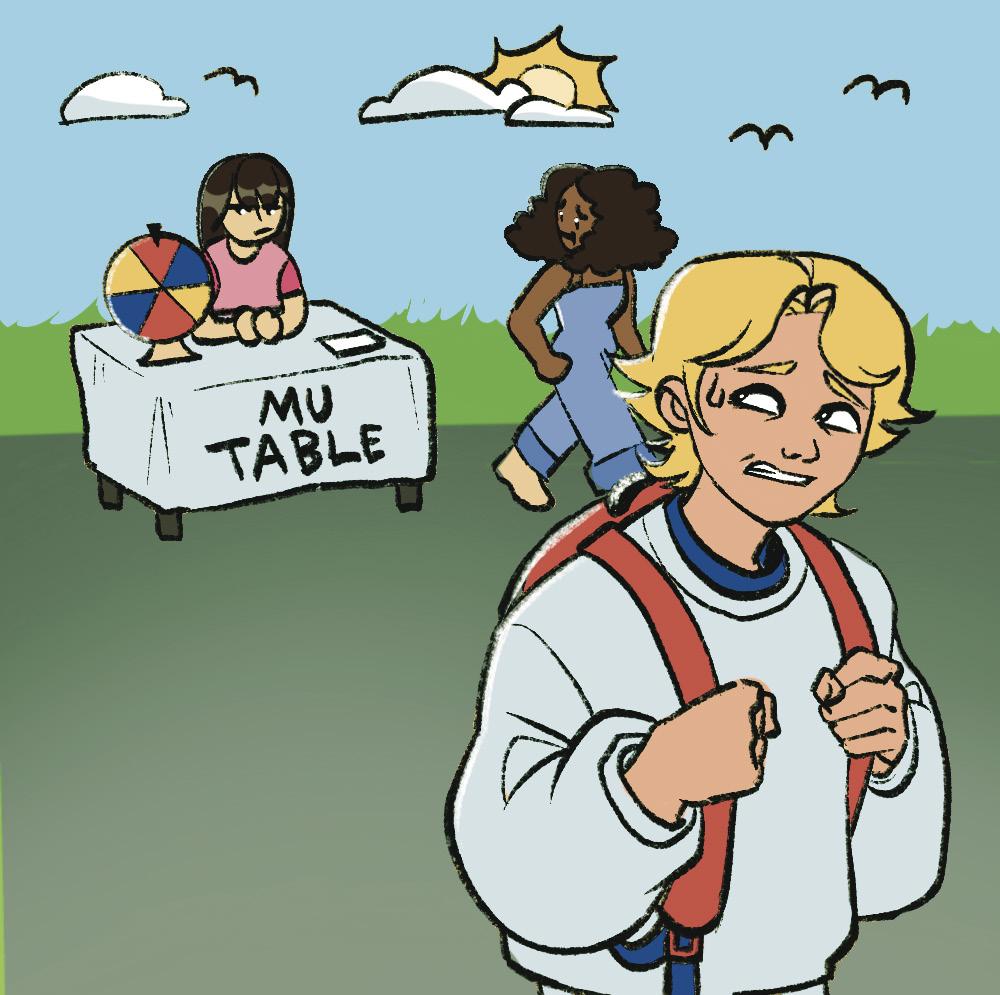
In my tenure both tabling and avoiding tables, I’ve come across a few prominent and successful strategies.
Modern innovations have brought us the cellphone, which has many uses — the best of which is looking at your lock screen really intently when you don’t want to lock eyes with an especially pushy table. Next, the speed walk is an oldie but a goodie. How can a tabling student even think of stopping you if you pass them faster than they can say, “Free stuf?”
A personal favorite of mine is the guilt trip. As you walk by the table, make sure to let that stress you’ve been feeling all day really show on your face. Te more visible your distress, the worse of a person that tabler would be for trying to haggle you. Bonus points if you can shed a single tear. While a little less theatrics, switching all the way to the far side of the sidewalk also gets the job done. Only excessively dedicated students will breach the distance and haggle if they have to yell. Te only downside to this strategy is that, when done ungracefully, it’s comedically obvious. Ten, there are those lucky few who walk around with genuine horse blinders, which is the ultimate strategy, however unintentional. Te easiest way to avoid a table is to not even know it’s there! Ignorance truly is bliss. As dreadful as tabling and being tabled at can be, it’s (mostly) nobody’s fault. Whether it’s rejection therapy for you or whether you’re the rejection therapist yourself, at some level we all understand each other. I don’t want to yell at you and you don’t want to feel guilty for ignoring me. Te tabling cycle is an endless struggle; College students may be trapped ‘till the end of time. So, if you have the time, stop by — or don’t, we don’t blame you.
San José to Los Angeles, are pushing back against Newsom’s encampment enforcements. Matt Mahan, the mayor of San José, argued that “clearing encampments only works if we have places for people to go” and said that “every city must have equal resolve in expanding shelter and in-patient treatment beds.”
Disclaimer: (Tis article is humor and/or satire, and its content is purely fctional. Te story and the names of “sources” are fctionalized.)
As of late, the city of Davis has been fairly quiet about their stance on Newsom’s orders. However, Davis’ ofcial protocol is to frst send the city’s Homeless Outreach Team to engage with an encampment in order to ofer services, then to partner with Davis Police for crisis assessment and lastly to have the Davis Police “maintain public order and enforce the law” — meaning the forced removal of an encampment. Despite being labelled as a “progressive college town,” there is a lot of local anti-homeless sentiment among the Davis Police Department and certain small business owners in the Downtown Davis Business Association (DDBA).
NEWSOM on 11
The Editorial Board recognizes women’s fight for equality, amidst their longstanding discriminatory treatment in everyday institutions
WRITTEN BY THE EDITORIAL BOARD
March 8, 2025 marked the global celebration of International Women’s Day, with this year’s campaign theme being “Accelerate Action.” Te day commemorates the continuous fght that women have been participating in for equality and liberation along with the women’s rights movement.
Aside from the general celebration that the day welcomes, 2025 marks the 30th anniversary of the Beijing Declaration and Platform for Action, one of the most progressive blueprints for advancing women’s and girls’ rights worldwide.
However, acknowledging women’s fght for equality shouldn’t be limited to this one occasion, as continuous conversation through the media, government, corporate leaders and community is necessary for the younger generation of women to feel empowered. In the face of so much global uncertainty, it is more important than ever to uplift and empower the women in our lives.
Economically speaking, the wage gap between men and women does still exist, with women earning an average of 85% of what men earn as of 2024. Tis gap has decreased over time but has hardly moved in the past two decades. Historically, this has been attributed to the fact that women are more likely to step back professionally in order to raise families than men — an assumption that is still refected in the pay gap.
Further in terms of the workplace,
Read The Editorial Board’s interview with Gary May and campus leadership
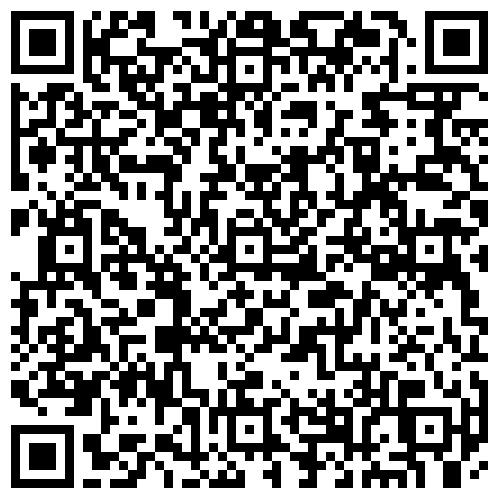
women have historically faced workplace discrimination, casual misogyny and often do not receive the same level of respect in positions of power. For example, a man who might be known for “taking charge” or “being a leader” in the workplace might be referred to as “bossy” if he were a woman. Tis form of bias permeates the workplace, academic forum and countless others and must be recognized.
Respect for women in the workplace has increased signifcantly over time, but assumptions and innate biases are still very present. In STEM felds, women are disadvantaged and overlooked when applying for professional opportunities. Additionally, there are less research studies conducted on women’s health compared to men. Tis systematic exclusion of women results in isolating women from their place in the research feld.
With female recognition often falling short in many diferent areas, our very own Te California Aggie is made up of a female majority and continues to foster a supportive environment for our staf and readers alike.
In the political forum, women have received more recognition than ever before in recent years, with Hillary Clinton and Kamala Harris both running as presidential candidates in the 2016 and 2024 elections, respectively. However, both candidates faced more scrutiny for their personality qualities than their male counterparts — which was Donald Trump in both election cycles — and faced gender criticism, and even race-based criticism in Harris’ case, on their ability to adequately run the government.
In this acknowledgement of women’s struggle for equality, it is also important to recognize the disproportionate adversity and scrutiny that women of color face. In every aspect of our society, women of color are subjected to discrimination, including with regard to socioeconomics, healthcare access and psychological and physical abuse. Even under the umbrella of feminism, it is equally vital to be anti-racist as it is to be feminist and uplift women of color.
More than ever, Trans-
Exclusionary Radical Feminism is being given a political platform amid
The death of hobbies College kills students’ time for passion projects and extracurriculars
BY SABRINA FIGUEROA
“What do you like to do for fun?”
If I was still in high school, I would be itching to answer this question with all of the hobbies I was actually doing, but ever since I started college, I hate answering this question. Instead of excitedly describing all of the projects I’m working on, I have to answer with hobbies I dream of doing when I eventually have time or am not overcome by exhaustion.
I used to be obsessed with painting, drawing and sketching when I was younger. I still have sketchbooks full of slightly ugly art that I refuse to throw away because they are proof that I was once unafraid to “waste” time. And if I did it once, I can do it again — eventually. Tere’s a sketch book from the year I graduated high school waiting for me, which I stopped drawing in around the time I began my frst year at UC Davis — I still keep it in hopes that I’ll pick it back up again.
One of my friend’s birthdays was over the past winter break, and I wanted to be crafty and save money. So, instead of going out and buying a card from the store, I sat down to watch the second season of “Squid Game” and made her a card. I followed tutorials, cut paper and colored with colored pencils and then it hit me: Te card was still mediocre and plain at best. I sat there and wondered where all of my creativity and innovative risk-taking had gone. Most importantly, I realized that I had forgotten how fun it was to simply create things, even if my work wasn’t on par with Picasso’s or one of the other greats. And it’s not just me, either. After I gave my friend the homemade card, we began to talk about how college and the pursuit of great careers deprived us
and even go to parties, but those are not creative hobbies — some are not hobbies at all. Tere are little to no instances where we allow ourselves to just sit and create random things that don’t necessarily have a purpose outside of amusing ourselves. As students, we are conditioned to do or create things for two reasons: to achieve a grade or to further our career goals.
It’s good that we have this obligation to put school and our careers frst, since education is fundamental to our society, but it’s insanely stressful to think about school, our careers and the future all the time. Tis is also not the way we were meant to live our human lives. We were meant to simply exist at frst, so we owe it to ourselves to pick up random hobbies — drawing, knitting, crocheting, coloring books, scrapbooking, woodworking, cosplay, metalworking, origami and more — that remind us how to bring our heads down from the clouds and live in our present lives. Tey also remind us that we are creatures whose abilities allow us to be innovative and creative in the frst place, which is something that cannot and should not be taken away. Sometimes, I wonder if I will ever pick up those sketchbooks again. I surely hope I will, but the one thing that stops me is how to start. I could sit here and write about how to get back into pursuing your hobbies in the midst of work and school, but I genuinely don’t know how — I’d be a liar if I tried to pretend like I did.
I suppose that this is something we will all eventually learn in our own time, and if you already know how, cherish your hobby and your ability to do it freely. If you don’t, remember that it’s okay to not do a million things at once — seize that spare moment of time just to create for yourself and no one else.
Disclaimer: Te
the current administration’s antitransgender agenda. Given this shift in political focus, Women’s History Month, while a month of celebration and empowerment for many, can feel exclusionary to trans women. Feminism includes all women, and it is important to acknowledge trans women’s battle for equal rights and recognition in all aspects of society — the workplace, bathrooms, sports and beyond.
In addition to institutional diferences that spark diferential treatment between men and women, there are also unfair standards placed upon women in terms of their outward appearances. Women are expected to be put-together, wear makeup, dress well, adhere to unrealistic body image standards and are still constantly over-sexualized, even when they do meet these unrealistic expectations. Men almost never face this same level of expectation for their physical appearance — and almost always are exempt from public scrutiny. Tese standards are hypocritical and wildly unfair and have become far too normalized on a societal level.
LGBTQIA+ women are also subject to heightened levels of already-existing misogyny and sexism. While recognizing the LGBTQIA+ community during Women’s History Month, it is important to acknowledge that unfair standards against women are also prevalent for individuals who don’t present themselves as the “ideal” version of femininity, including non-binary or masculine-presenting individuals.
Women’s History Month is not only for white, cisgender, heterosexual women, and there are many areas of intersectional feminism that were not covered in this editorial. As you go through the rest of March, take the time to ensure your feminism is not limited or exclusionary — inclusivity is just as important as feminism itself. With the rise of the #MeToo movement in 2017, women have felt more inclined to share their experiences of sexual abuse and harassment in a space where they feel seen, heard and most importantly — supported. Te phrase “Me Too” was frst used by sexual assault survivor and activist Tarana Burke in 2006 on MySpace, but the “#MeToo” was widely popularized on social media to empower those who had faced similar experiences and to demonstrate the
Editorial Board
CHRIS PONCE Editor-in-Chief
ALYSSA CREVOISERAT Managing Editor
MADISON PETERS Campus News Editor
HANNAH SCHRADER City News Editor
MAYA KORNYEYEVA Opinion Editor
ZOEY MORTAZAVI Features Editor
ANA BACH Arts & Culture Editor
MEGAN JOSEPH Sports Editor
KATIE HELLMAN Science Editor
JENNA LEE Photo Director
ARIANA NOBLE Layout Director
LANHUI ZHEN Design Director
JOANNE SUN Social Media Manager
AARON POTTER Website Manager
CASSIDY GILLIS Distribution & Outreach Director
TIFFANY HE Copy Chief
JENNY DYE Copy Chief
SAMUEL RUIZ Translation Director
ILEANA MERAZ Translation Director
LAURIE PEDERSON Business Development Manager
alarming amount of sexual harassment and assault in the workplace. Films, media and TV shows uplifting women have become more and more prevalent, with popular recent examples including “Barbie” (2023), “Hidden Figures” (2016), “On the Basis of Sex” (2018) and “Te Substance” (2024). Tese forms of media, while not as immediately instrumental as systematic changes, are indicative of a larger shift toward embracing womanhood and empowering new generations of feminist activists. While there are countless roadblocks and mistreatment that women face every single day, the struggles of women have contributed to their resilience and strength. Despite its lack of federal recognition by the current presidential administration, uplift and commend the women in your life. Give women the grace and respect that they deserve in your everyday interactions — during this month especially, but also every day.
BY CALEB SILVER chsilver@ucdavis.edu
The ruling of Wardlow versus Illinois (2000), put succinctly, is evil and has a malicious lack of foresight. Sam Wardlow was walking in what was pre-conceived by police ofcers as an area in Chicago with higher crime rates than average. He saw a police van and then fed. Te ofcers pursued Wardlow, detained him and found an illegal frearm on his person.
T is case went to the Supreme Court, because Wardlow argued that the actions against him were in violation of his Fourth Amendment right, which protects an individual from unlawful search and seizure. Te majority argued that, though running away from police is not enough to permit reasonable suspicion — which is what is needed to detain and search a civilian without a warrant according to the Fourth Amendment — doing so in a high crime area is. Essentially, the Supreme Court of the United States (SCOTUS) made it known that civil liberties vary depending on the location. In this particular case, there is no substantial evidence that Wardlow was running because of the police. Could there have been someone behind the police van? Was he running away simply because this was, as labelled by the police, a “dangerous” area? Does he not have the right to do so? Or, if you don’t wish to humor me, is it not okay for Wardlow to just run from the police for no reason whatsoever? Te police can be pretty terrifying, especially when they are present in these so-called dangerous areas (case in point).
T is 25-year-old case is not an outlier. In fact, it’s probably somewhat
sane considering the makeup of the current Supreme Court. Since 2020, SCOTUS has had six Republicanappointed justices, leading the court with a majority over the three Democratic nominees. Te six include “thinkers” like Clarence Tomas, who “failed to disclose years of lavish trips from wealthy conservatives,” according to MSNBC News.
Corruption is actually a core tenet to this SCOTUS jurisprudence, as demonstrated by their ruling in Snyder versus United States. In this case, the majority, written by Chief Justice John Roberts, claims that a gratuity (which is essentially a bribe given as a sort of unofcial “gift” after the fact) given to a government ofcial is, apparently, allowed — despite 18 U.S. Code § 666 specifcally prohibiting such gifts or bribes if they exceed $5,000. For context, James Snyder accepted a $13,000 gratuity from a company for giving them a city contract, and he was found guilty in a jury trial. Snyder then appealed his case until it rose to the Supreme Court, which is currently full of judges who accept gratuities like it’s a part of their job.
Tis is not to mention Grants Pass versus Johnson, a case that decreed that the Eighth Amendment outlawing cruel and unusual punishment does not apply to banning unhoused people from
sleeping outside; I should not have to describe why that one is wrong. Banning people who don’t have a house for not sleeping in a house is the defnition of cruel and unusual. Tere is no reason why this shouldn’t fall under the Eighth Amendment, besides the fact that many conservatives do not care about unhoused people and believe punishing them is an efective way to end homelessness.
Te jurisprudence of the Roberts Court seems to not be defined by any actual legal, logical or progressive decision-making. Similar to the decision made in the Wardlow case, they seem to work backward from preconceived political ties. T e court consists of judges who have strict right-wing partisan ties and practice bizarre forms of textualism and constitutionalism — trying to twist the facts of the case to appease their billionaire buddies and keep steadfast preconceived ideologies. Tis is how the Supreme Court was designed to operate, and unless we have justice reform, this will continue to strip us of our civil liberties and erode our country’s democratic systems.
Disclaimer: Te views and opinions expressed by individual columnists belong to the columnists alone and do not necessarily indicate the views and opinions held by Te California Aggie.
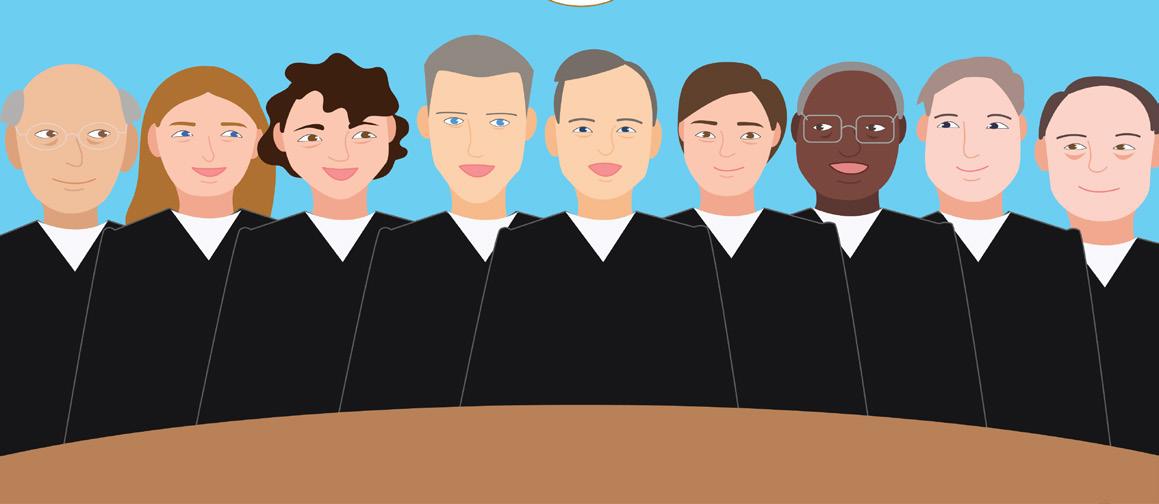


‘Following Your Heart’s Compass: Cultivating Your Authenticity’: UC Davis student Aidan Hyman’s TEDx talk
The recognized marathon runner and United Nations delegate hosted a campus event through TEDxUCDavis
BY SHREYA KUMAR arts@theaggie.org
On Mar. 6, TEDxUCDavis held an interactive pop-up TEDx Salon event at the ASUCD Coffee House from 6 to 8 p.m. Featuring Aidan Hyman as the keynote speaker, the event provided a space for thought-provoking discussions on authenticity and personal growth. Attendees enjoyed an evening of reflective, interactive workshops while indulging in free snacks in a warm and welcoming environment.
Hyman, a third-year agricultural and environmental technology major at UC Davis, is also a queer social entrepreneur, humanitarian and renewable energy advocate. His talk, “Following Your Heart’s Compass: Cultivating Your Authenticity,” included him speaking at length about his perspectives on motivating himself and others to face uncertainty head on, as well as his experiences with learning how to conquer fears that hold you back from doing what you want.
Shriya Nagulapally, a fourth-year music and physics double major and the director of the TEDx Speakers Team, worked closely with Hyman to write and develop his speech, helping refine his experiences and ideas into an engaging message.
“With this being our first pop-up TEDx event, we were not sure how everything would go, but between [Hyman’s] talk and the workshops, it was a great success,” Nagulapally said.
Outside of the TEDxUC Davis event, Hyman has modeled energy efficiency projects and conducted research on nuclear fusion trends for UC Davis’ Bodega Marine Lab. Beyond academia, Hyman has taken on extreme challenges, such as skydiving and climbing K2, the second-highest mountain on Earth.
Along with his studies, Hyman holds the title of a Tree-Star WorldMarathoner in the Abbott World Marathon Majors series. He has also completed marathons in Boston, New York City and Chicago. Additionally, he has competed in Ironman 70.3 Hawaii and was nominated to be one of Attitude Magazine’s most influential queer trailblazers of 2024. Hyman is also an Athlete for Equality with the Human Rights Campaign and has worked in environmental affairs as an intern at the United Nations Economic and Social Commission for Asia and the Pacific (ESCAP) headquarters in Tailand.
Te TEDx event served as a preview of an upcoming largerscale TEDx event, UncharTED, which will be a full-day conference featuring a diverse array of speakers from across the country. Although TEDxUCDavis has held conference events before, such as their successful WholehearTED conference last year, a TEDx Salon event has never been held at UC Davis.
“Salon events are often small weekly or monthly events that keeps [...] community engaged between regular TEDx events,” the TED website reads.
Unlike the standard conference events, which feature mainly professionals and researchers on a grand stage, Salon events highlight student voices in a more casual setting. Te welcoming format allows for more interactivity and encourages an open dialogue between the speaker and the audience.
Hyman’s talk was followed up by a Q&A session that allowed attendees to directly engage by asking questions and sharing their own insights related to the topic. After a short break, Hyman led participants in a guided journaling session, asking them to reflect on their own experiences with uncertainty and discovery to understand how to apply his philosophies to their own life experiences.
Afterward, attendees mingled during a social bingo workshop. Each bingo card contained questions in the spaces, and everyone had to find
someone who could fill in each space based on which prompt they had personally experienced.
Neha Kaul, a fourth-year cognitive science major and president of TEDxUCDavis, discussed what makes TEDx the opportunity it is.
“I love TEDx because it truly brings communities together,” Kaul said. “It’s inspiring to see the passion not only from our team members but also from the speakers and attendees. Te opportunity to exchange ideas with some of the brightest minds is truly a once in a lifetime experience.”
Te Salon was more than just an event — it was an invitation to explore the uncharted. For those who attended, the evening served as a powerful reminder that stepping into the unknown often leads to the most transformative discoveries, and for those who missed it, don’t worry — the journey is just beginning. You can watch Hyman’s talk on the TEDxUCDavis YouTube channel, along with talks from last year’s conference.
Additionally, Hyman will be representing the Ironman Foundation and competing in Ironman Texas this April, for which he is currently raising funds. Visit his website or his Instagram @aidanhyman to learn more and offer your support. Be sure to mark your calendars for this year’s conference, UncharTED, taking place at California Hall on April 26.

The UC Davis Indian Student Association hosts an official event to commemorate the Hindu holiday
BY DEVANSHI AGNIHOTRI arts@theaggie.org
A rainbow of colors will fill the sky and water balloons will burst with colored water, because March 14 marks the official time for the annual Hindu holiday, Holi. Celebrated as the “Festival of Colors,” Holi is celebrated on a different day each year to mark the end of winter and the start of spring. Te celebration occurs on the last full moon of the lunar month of Phalguna, typically on the 12th month in the Hindu calendar.
Te Hindu “Festival of Colors” honors the triumph of good over evil, with people lighting bonfires to say their goodbyes to winter, throwing bright powders and water and ringing in the change in seasons.
Holi is celebrated in a variety of ways — the day before Holi is known as Chhoti Holi, and a bonfire is lit to symbolize good over evil. On Holi, people gather together and throw colored powder and water at anyone they see. For the celebration, people typically wear the oldest clothes in their closet, preparing for them to get ruined with colored powder and water; Each swipe of color on a person’s face is a moment of endearment.
In addition to the colored powder, water also gets involved in the celebration. Many people use water guns, water balloons or even buckets of water and playfully splash water at each other. Saanvi Bapu, a third-year cell biology major and president of UC Davis Indian Student Association (UCDISA), described first-hand experience of the festivities.
“You go in with a set of friends and you’re just playing [alongside] them, but at some point, everyone is usually just playing [alongside] each other,” Bapu said. “You’re just throwing up colors in the air, and you can make new friends in the process. Even if you don’t talk to them and names aren’t
exchanged, you’re all just having fun with the people there.”
Te Indian Student Association at UC Davis is a student-run organization that focuses on highlighting Indian culture at UC Davis and works with other South Asian organizations. Te organization hosts gatherings on Hindu holidays like Diwali and Holi, as well as holds the Garba Night, Davis Dhwani and study social events.
Te Indian Student Association at UC Davis is the only undergraduate [student-run] organization at [UC Davis] that allows for Indian as well as other students interested in Indian cultures and traditions to unite under one common organization,” the UCDISA website reads. “Our main goals are to bring the UC Davis community closer through holding social events for cultural awareness [and] fundraising for the underprivileged community.”
Holi is a lively event and acts as an easy mode of connecting with others without having to socialize. Students far from home may be missing the traditions with their family such as the sweets their parents would make or the matching Holi outfits, but the Davis community brings similar sentiments to the local celebration — fostering a cultural connection within the college town.
“You might not find these events so easily in a lot of places, especially for the students from India that may be missing these festivals,” Bapu said. “One of our main goals is to host these kinds of events so students can feel more connected to their culture.”
For those interested in celebrating the holiday, bring your friends and show your love by spreading some color at the official UCDISA Holi event on April 19. For students unable to attend the celebration, remain up to date with UCDISA’s future events and club membership by accessing the UCDISA’s Instagram page and website.

The exhibition was made possible by the Shingle Springs Band of Miwok Indians, which Fonseca was an enrolled citizen of
BY SAVANNAH ANNO arts@theaggie.org
Te Gorman Museum of Native American Art will be showcasing the work of Sacramento-born artist Harry Fonseca (1946-2006) from Feb. 12 to Aug. 31. Influenced by his Nisenan Maidu, Hawaiian and Portuguese heritage, Fonseca’s work — while shifting stylistically over the decades — at its core, works to challenge and expand pre-existing Western conceptions of what it means to be Indigenous.
Te solo-exhibition chronicles Fonseca’s lifework, with pieces ranging from the mid-1970s to the early 2000s. Te work is arranged to reflect
Fonseca’s versatility and development as an artist, weaving a story between his meticulous paintings of Maidu dancers, his popular “Coyote” series, rock-art inspired “Stone Poems,” political pieces centered around the genocide of California’s native people and finally his transition to abstract art toward the end of his life.
Te Gorman Museum was able to display such a wide selection of Fonseca’s work thanks to the Shingle Springs Tribe who, in 2023, brought over 1,000 of the artist’s paintings, drawings and sketches into their collection.
Fonseca was a citizen of the Shingle Springs Tribe located just east of Sacramento where he was born. Fonseca was also a student

at California State University, Sacramento under Nomtipom Wintu native Frank LaPena, whose work has been shown across the country since the 1960s.
In many ways, the first exhibition of the tribe’s recent acquisition being curated at the Gorman Museum was a homecoming for Fonseca’s work back to Northern California, the largest collection previously being held at Te Autry Museum of the American West in Los Angeles.
Te important thing was that we worked closely with the Shingle Springs Tribe,” Executive Director and Curator of the Gorman Museum Veronica Passalacqua said. “I’ve wanted to do a show of [Fonseca’s] work for a very long time. I was thinking I would use some from their collection and some from these other collections, but the Shingle Springs Tribe acquired so much in such a wide range, we decided to keep it within their collection and present it together.”
Te Fonseca exhibit stretches across about half of the Gorman Museum’s gallery space, the rest being filled with works from their permanent collections of Native American, First Nations and Indigenous artists.
“My selection was from what I saw, knowing our space and how I could highlight each area,” Passalacqua said. “It was important to me to really emphasize the California works, even though the ‘Coyote’ series is his most popular.”
Trough the strategic placement of walls and title cards in order to create physical distance between each section, visitors are able to easily grasp the various stages of artistic creation and thinking Fonseca moved through during his career.
Te series Passalacqua mentions, Fonseca’s “Discovery of Gold and Souls in California,” takes up a
separate wall in which visitors are able to take their time examining each small, mixed-media piece. Different from the rest of his works in which the focus is usually a detailed human or animal form, these pieces speak to the genocide of California’s indigenous communities with images of gold, crosses and handprints.
“It is a direct reference to the physical, emotional, and spiritual genocide of the native people in California. With the rise of the mission system, and much later the discovery of gold in California, the native world was fractured, and with it, a way of life and order devastated,” Fonseca said in a quote featured within the Gorman Museum’s wall text.
Te exhibition includes written descriptions of each section of Fonseca’s work, with most, if not all, featuring quotes by Fonseca himself.
“We wanted those panels to be first-person quotes directly from the artist because he’s no longer with us,” Passalacqua said. “Tat’s part of how we operate, we’re artist-led. I’m not speaking for the artist, or asserting my education over what the artist has to say, and that’s always been important, especially when you’re talking about Native artists.
Fonseca’s words also influenced Passalacqua’s curation, paying special attention to the way he wanted pieces exhibited in the past. His “Stone Poems,” large paintings on sheets of canvas inspired by rock art and petroglyphs he studied in the West and Southwest, stand out in the exhibition’s far corner, away from the rest of the smaller works in the collection.
“Harry never wanted them on stretcher bars, he wanted them flat on the wall, so we did that per his wishes,” Passalacqua said. “But then, I also hung them a little higher than
I normally would for that same idea — to emphasize that when you come up to it, you have to look up. Tat was how he experienced the paintings, so I thought that was important.”
With thoughtful curation, an inside look into Fonseca’s own descriptions of his artwork and the usage of a local, Native American art collection, the Gorman Museum highlights the importance of regional artists and their voice within art history.
Visitors of “Olé Ham Nees: We Call Him Coyote,” are able to experience a decades-long evolution of Fonseca’s technical skill and artistic motivations.
Centered by way of the exhibition’s name, Fonseca’s “Coyote” figure is the subject of his most-celebrated series. Beginning to draw Coyote in 1979, visitors can follow Fonseca’s sketches and watercolor prints of the dancing figure to his popular iterations of Coyote in various outfits and settings, such as the San Francisco Mission District and a performance of “Swan Lake.”
Colorful and adventurous, described by Fonseca as “a Native American folk hero,” Coyote — dressed in leather jackets, jewelry and sneakers — fights for the Native American identity to be perceived as nonstationary, as explained by the Gorman Museum’s artist biography. Open until Aug. 31, prospective visitors have plenty of time to catch this all-encompassing exhibition of Harry Fonseca. Accessible to every kind of audience, Fonseca’s work speaks to both the playfulness and complexity of human nature.
“It’s a fabulous show and you don’t have to have Native history to appreciate it,” Passalacqua said.
Enter digits from 1 to 9 into the blank spaces. Every row, column and 3x3 square must contain each digit. Each Sudoku has a unique solution that can be reached logically without guessing.

Please follow my new Etsy shop: “Designz by Designer”
BY ALLISON KELEHER
adkeleher@ucdavis.edu
I recently got Canva Pro, and it has changed my life. Now that I have so much power at my fingertips, I sometimes get overwhelmed by all of my creative ideas. Not to sound cocky, but graphic design may or may not be my new career. It would be a disservice to keep this heat to myself. What is this heat you may ask? Well, you are in luck, because I have just released my new t-shirt line.
My t-shirts are special, because I am harnessing the raw energy of Artificial Intelligence (AI) to generate groundbreaking designs. It all started when I asked my computer for a UC Davis design. It spit out a cow at me, and I bonked myself on the head because I hadn’t thought of that.
Tis was just the beginning; After that first design, I was able to really start cranking out ideas. It was so easy, too! I only spend one hour a week managing my business, which leaves ample time for me to keep up with my classes. I started out by putting my designs only on white t-shirts, but now I’m thinking of expanding into other colors. It might be time, because I’ve already received five orders, meaning that things are heating up (only two of the orders were from my mom).
I even looked into trademarking my designs so that no one would steal them from me. However, it’s pretty
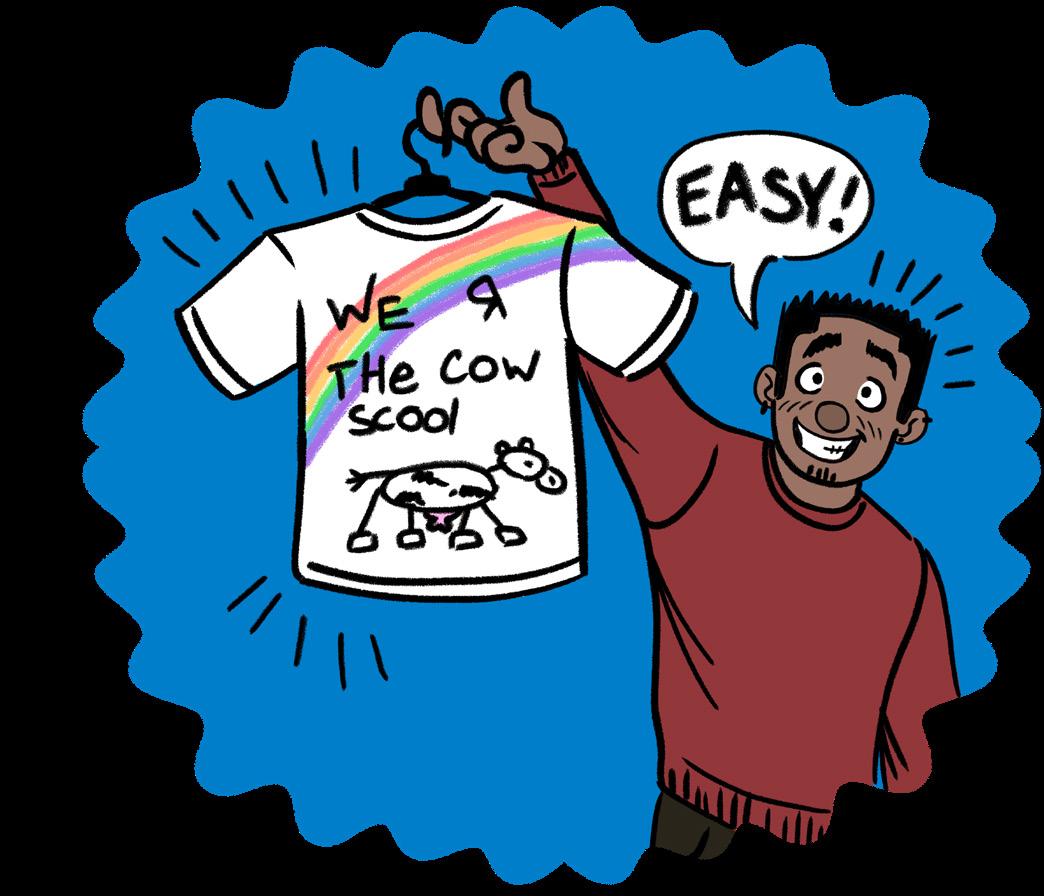
complicated to acquire a trademark, especially when the content is AI-generated. Te attorney fees alone would have cleaned me out. Tis business is supposed to be bringing me money; I need to cover my Canva Pro costs. Last week, I took my designs to the craft fair near the Davis Farmers Market and they were a hit! Almost 10 people stopped to take a look. Even though only three people bought one, I felt super successful. If anyone tells you that I gave them a discount, don’t believe them. I only sell at a premium, since the designs are so good — only the best AI works for me. I’m currently expanding my operations to accommodate the surge in demand that I’m expecting from the Craft and Vintage Fair publicity.
ere are currently multiple tabs open on my laptop creating content. Once I have some free time, I plan to put these beautiful designs on Canva and my dreams will become reality. I am considering contracting out a printer so that I can make these in bulk. My mom is my biggest supporter and I couldn’t do it without her. She suggested the Etsy shop since that would help me reach more customers. It is now up and running, so please go check out my whimsical cow designs.
Disclaimer: (Tis article is humor and/or satire, and its content is purely fctional. Te story and the names of “sources” are fctionalized.)
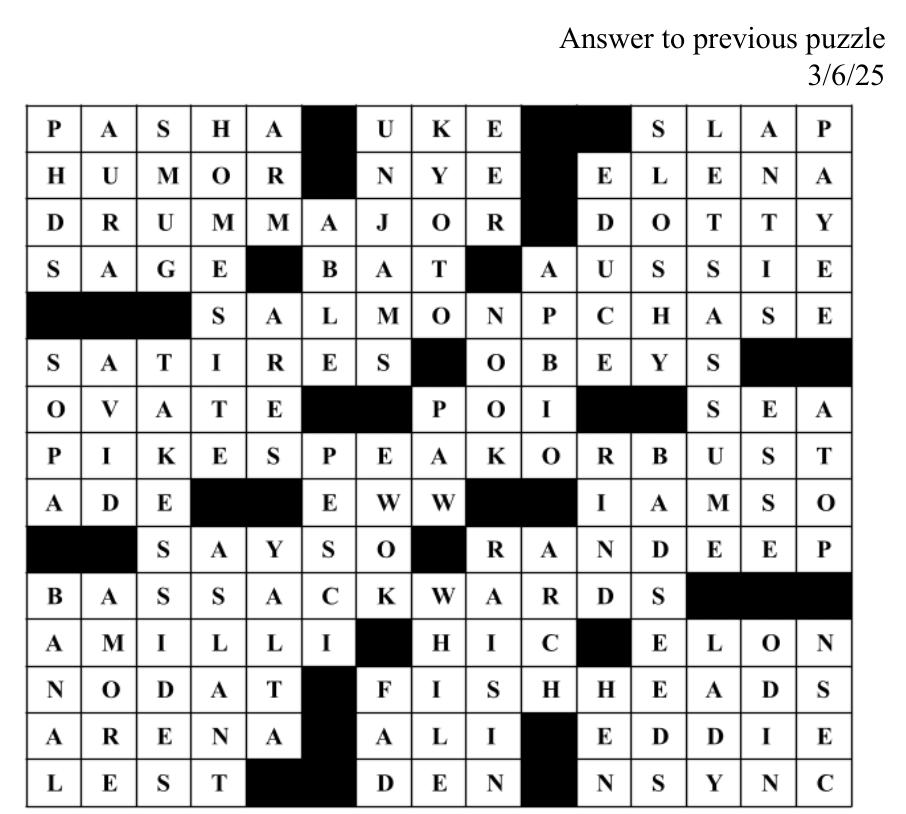
run a Health 34 program 24/7 for our students.”
Answer to previous puzzle 3/6/25 2X2X2
“We have mental health clinicians that respond with the city of Davis police department and other public safety agencies,” Mitchell said. “Tey work normal business hours, nine to five. Still, who’s responding to mental health emergency calls at night or on the weekends is the police department. We need to expand [the availability of clinicians], and we need to have clinicians responding to mental health throughout the county, including at UC Davis.” Mitchell also made two other recommendations. Te second [recommendation] is that crisis intervention training needs to be extended to all first responders, not just police — so that includes dispatch, fire and [emergency medical services],” Mitchell said. “Te third recommendation is that we need to work towards having a crisis stabilization unit in Yolo County. A crisis stabilization unit is a level above a mental health receiving center — a crisis stabilization unit is a [psychoeducational center] and it’s able to take all levels of psych patients.” Mayor Bapu Vaitla supported Mitchell’s recommendations. He asked Jenny Tan, the city of Davis Director of Community Engagement, to forward Mitchell’s policy brief to the city’s county and University of California partners. Vice Mayor Donna Neville supported the construction of the Receiving/Sobering Center as an alternative to those in a mental health crisis going to the ER.
“You want to be in a place that’s safe, where there’s trauma-informed care, where you will get care from people who are specially equipped to help you,” Neville said.
“Tat is why the Receiving Center is so important for medical reasons and psychological reasons. It’s also fiscally a better approach than taking people to the ER, which has its own suite of expenses.”
Neville, who serves on the Yolo County division of the National Alliance on Mental Illness, said that 75% of all mental illnesses emerge by the age of 25. Tere’s a critical period in life [of the three years] until you reach 25 when mental illnesses emerge,” Neville said. “It’s so important to have good preventative care, response care and clinical care during those periods.”
Neville invited UC Davis to collaborate with the city in efforts to address mental health. Clare Shinnerl, the vice chancellor of UC Davis Finance, Operations and Administration, said the university has met with the interim fire chief to learn more about city programs.
“One of the next steps we’ve decided is to try to create a gap analysis, like, ‘What are we doing?’ versus ‘What are you doing?’” Shinnerl said. “We [also]
Councilmember Gloria Partida thanked the university for its support.
“I’m glad to hear that the university is helping us with housing students and in a number of other ways, including mental health,” Partida said. “I think we as a community feel a responsibility to the young people that are part of our city for four years, five years, however long they’re here. If we can work together, it is something that will benefit all of us and our future.”
“With regard to student government activity, the University of California Policies Applying to Campus Activities, Organizations and Students (PACAOS) provides the relevant policies and guidance, such as the authority over their constitution and by-laws, ability to take positions on public issues and requirement to follow university policies. Te topic of divestment for the University of California was addressed in a statement from April 2024.”
The aforementioned statement states that the UC opposes boycott and divestment movements against Israel, citing a loss of academic freedom. It also states the UC’s tuition and fees go toward university operations and not investment, as well as mentions that UC Investments is providing stable and growing revenue that benefits employees, education, research and public service mission.
Sulur detailed the next steps of the LSA regarding the amendment.
Tis week we are affirmatively reaching out to Sheri Atkinson as the King Hall community as well as members of the LSA board to make sure that we understand where they’re coming from and what their issues are, but their views were kind of sprung upon us without any formal notice,” Sulur said. “Hopefully, we’ll meet with them and gain a better understanding.”

From conception to execution, UC Davis community members share the immense effort that goes into creating a successful show BY EMME DUNNING features@theaggie.org
Live music is a vital part of the social lives of many UC Davis students. A hub for backyard concerts, underground raves and local community music events, the Davis music scene has long been celebrated as a cornerstone of student culture. However, while many students and community members attend these events, far fewer truly understand the full extent of what it takes to put a show together.
Caden Velasquez, a UC Davis alumnus with a Bachelor of Art (B.A.) in international relations and the founder of the local music collective DRC Creatives, previously known as Davis Rave Company, is acutely aware of just how much is required to create a memorable show. He also understands that this hard work is often unnoticed by the average attendee.
“[Attendees] buy their ticket, they show up, they have fun and then they leave,” Velasquez said. “You’re maybe seeing 5% of the entire show.”
So what accounts for the other 95%? Velasquez asserts that the entirety of a show is a major production that can take weeks, if not months, to coordinate.
“It takes a lot of people and time to put on a show,” Velasquez said. “Te frst step of the timeline is the concept. What you want to do, what kind of vibe you’re going for, who you want to attract and what kind of product you’re trying to create for people.”
Tis stage of planning is crucial, Velasquez asserted, as all elements of a show must work together cohesively to be successful.
“It has to mesh very well, and a lot of that goes into comprehensive planning,” Velasquez said. “You just want to make sure everything is compatible, comprehensive and complementary because, in the end, that’s what’s going to make a really good show.”
After a general vision is established, organizers start coordinating more granular logistics.
“Once you have a location and a date and an artist and really a concept, you can start to reach out and get other third parties involved — like vendors,” Velasquez said. “A few days before the event you start getting more into meticulous itinerary planning and who’s gonna be doing what, at what time and where, with who — so you want to make sure that you’re orchestrating a team really well.”
Velasquez said that although this planning is essential to the success of a
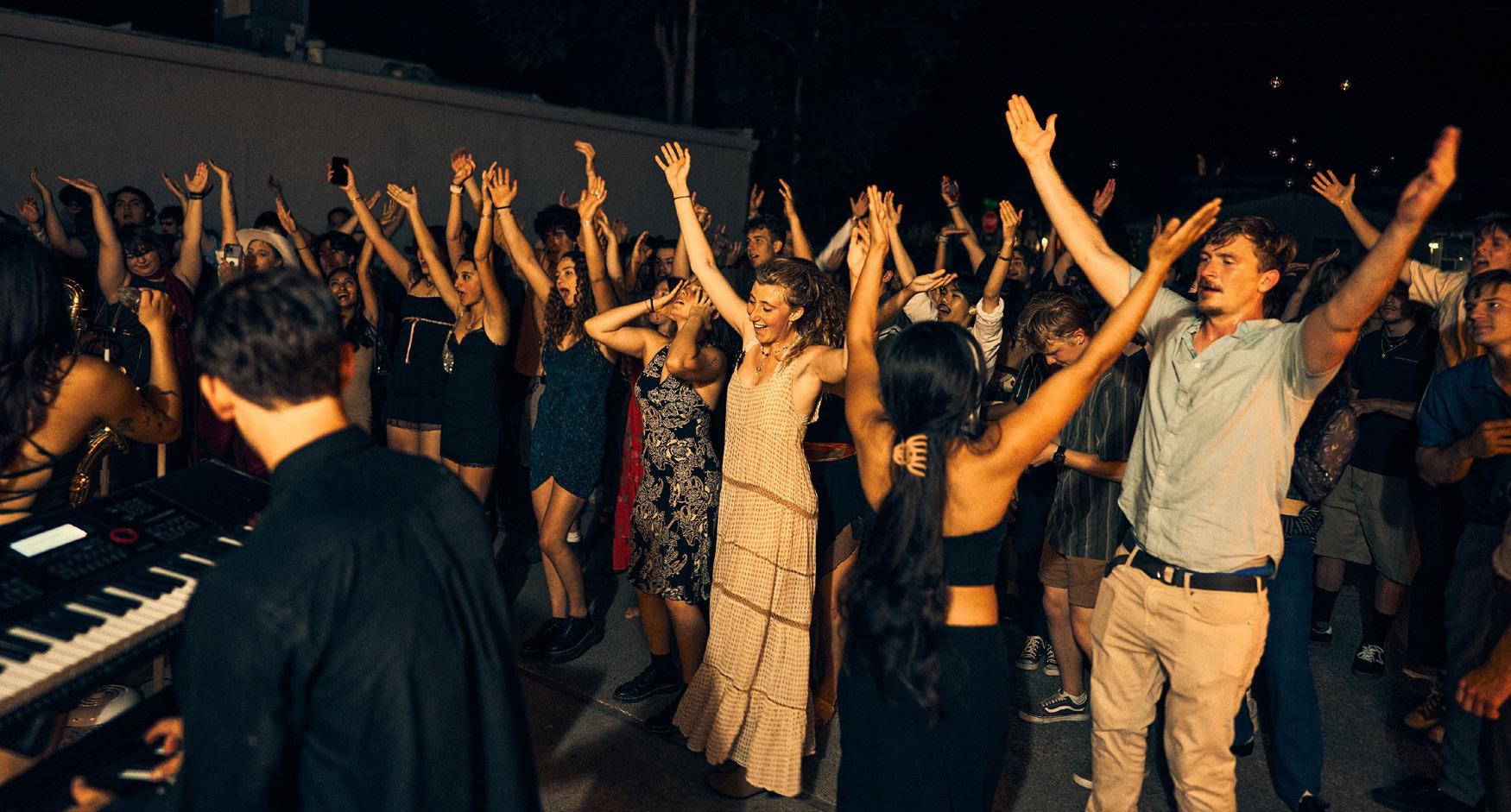
show, the most successful shows never let on to this massive efort.
“If you’re at a really good show, you should feel very immersed in the experience,” Velasquez said. “Never should you feel like you’re anywhere but that show.”
For Katya Jane, a UC Davis alumna with a Bachelor of Science (B.S.) in neurobiology, physiology and behavior, this behind-the-scenes work is a personal passion.
Jane is a former member of the locally renowned band Cowboys After Dark, her involvement in which propelled her into her current career as the founder and lead show producer for Velvet Red Productions. In this role, Jane is responsible for much of the logistics that go into creating a successful music event and is all too familiar with the sometimes lengthy planning process it brings.
Tere are so many layers that go into it,” Jane said. “I personally like to have about a month in advance to plan all the gear, make all the arrangements and get a really good fyer that’s engaging and easy to follow.”
During this month, Jane also takes time to introduce performers to their potential audience through social media.
“On Instagram, I like to do spotlight posts,” Jane said. “I like to highlight every band and kind of talk about them individually before the show so that people know who they’re going to see.”
As the show gets closer, pressure to perform well can mount for both musicians and crew members. To combat the expected stress from this,
Jane noted that having a solid and compatible team is essential.
“It’s a lot of people working on one thing so it’s really important to have camaraderie with the people that you’re working with,” Jane said. “Tere are so many moving parts, and it can get very chaotic. You have to make sure you’re able to communicate things efciently and get a lot of people on board to do one big event. Tat’s how these events become big and awesome and so much fun is when everyone comes together and does their part.”
Nola Zimdars, a fourth-year design major, has taken a particular interest in creative marketing and poster design for local music events, particularly with ASUCD’s Whole Earth Festival. Zimdars asserted the importance of design in shaping the underlying message of a show and attracting a key player — the audience.
“Design is so important,” Zimdars said. “A good design catches people’s eyes. If you don’t have a good poster, who’s going to come to your event?”
Being part of the music scene through designing f yers and other promotional content allows Zimdars to engage with the creative community, despite not being a musician herself.
“I get to be creative,” Zimdars said. “I’m not musically inclined, but I get to participate in the process and then I still get to just be in the crowd and also feel like I’m involved in the creation. It’s super rewarding to work hard and see your eforts come to fruition.”
For Zimdars, a major goal of promotional design is to expand the reach of the show beyond those who
Nowruz Celebration showcases Persian culture through music, dance and tradition
BY JALAN TEHRANIFAR features@theaggie.org
UC Davis students, faculty and alumni gathered at the Walter A. Buehler Alumni Center on March 8 to celebrate the Persian New Year during Nowruz Celebration, an event hosted by the undergraduate Iranian Students Organization (ISO). Te celebration brought together students of diverse backgrounds to experience the rich traditions of Nowruz, which marks the arrival of spring and the beginning of the Iranian calendar year.
Nowruz, which means “new day” in Farsi, is an ancient festival dating back over 3,000 years. It is celebrated not only in Iran but also in countries such as Afghanistan, Tajikistan and parts of Central Asia and the Middle East. Te holiday falls on the spring equinox, symbolizing rebirth, new beginnings and the triumph of light over darkness. Families traditionally prepare for Nowruz by engaging in khooneh tekouni (spring cleaning), buying new clothes and visiting loved ones. Te celebrations last for 13 days, culminating in Sizdah Bedar, a day spent outdoors in nature to bring good luck for the year ahead. Tis year, Nowruz begins on March 20, 2025 at 2:01 a.m.
The event featured traditional Persian music, food and cultural performances, immersing attendees in the spirit of Nowruz. Te student
performances included a poem reading by Telli Abbasian-Arjomand, a guitar performance by Bardia Anvari, a singing performance by Terme Arjomand and a violin and santoor performance by Negar Agah and Remi Seddigh. Te performances closed with a Persian cultural dance that was choreographed by the group’s board members, performed by Ayla Ajdari, Elina Sadeghian, Max Wakeman and Amanda Zanganeh Azam.
A highlight of the celebration was the Haftseen table, a beautifully arranged display of seven symbolic items starting with the Persian letter “S” that represent renewal, prosperity and good fortune for the year ahead. Items such as sabzeh (sprouted grains) for rebirth, senjed (dried fruit) for love and seer (garlic) for health adorned the table, drawing admiration from attendees.
Lila Salehi, a fourth-year human biology major, was born and raised in Iran and longed to fnd a sense of home at UC Davis — a connection she ultimately discovered through the Iranian Students Organization. Now serving as the group’s president, she was thrilled to share Persian culture with the broader Davis community through this special event.
“With only eight board members who are balancing school and planning [the event], we’ve worked incredibly hard to put together a night flled with performances, cultural booths, Persian food and dancing,” Salehi said. “Tis is the frst time the undergraduate student
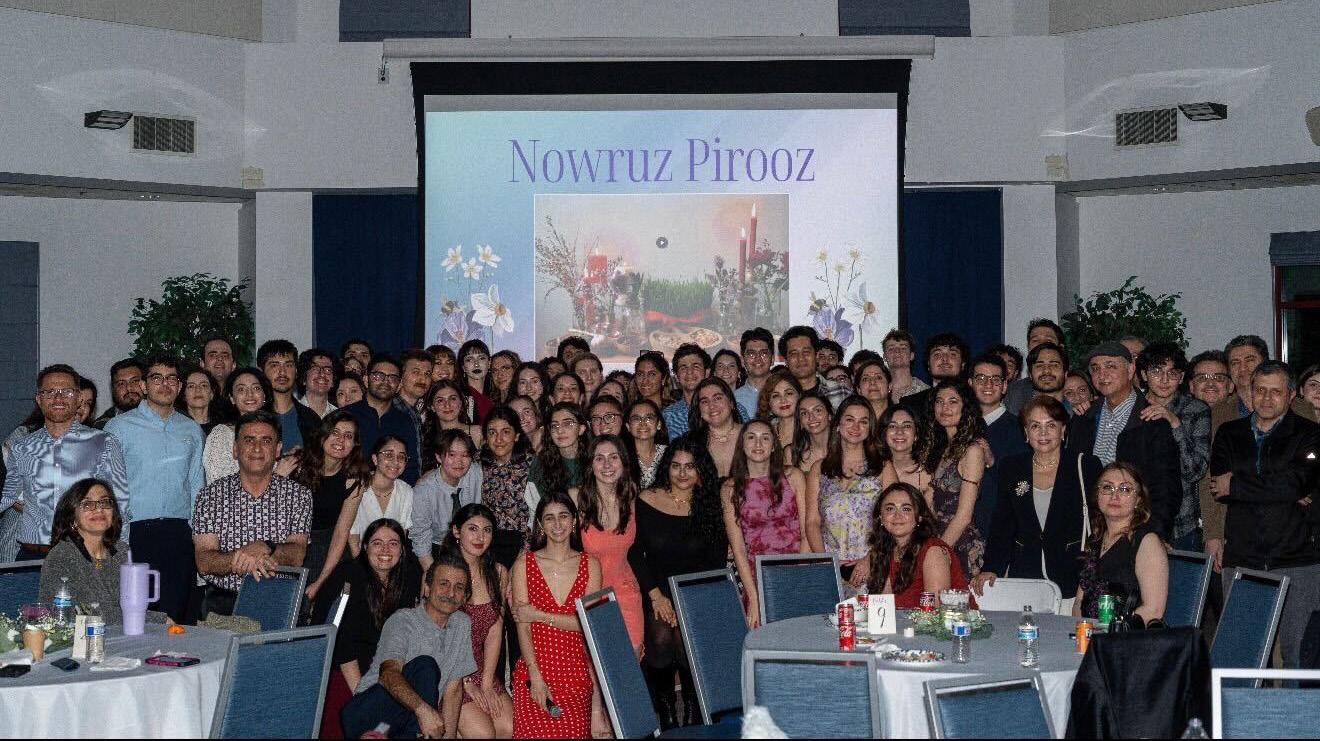
club is hosting Nowruz. In previous years it was the graduate students, but this year it’s all on us.”
Despite the challenges of organizing such a large-scale celebration with a small team, ISO’s leadership remained dedicated to ensuring an authentic and welcoming experience.
Te ISO sets up a Haftseen display at the Cross Cultural Center on campus, allowing students and faculty to learn more about this important tradition,” Salehi said. “I just hope that this event [and] the work that ISO does helps spread the joy and the cultural richness of Nowruz to even more people in Davis and the extended area.”
Ayla Ajdari, a third-year biomedical engineering student, serves as the social media coordinator for the Iranian Students Organization and performed a cultural dance at the event. Dressed in vibrant cultural attire, Ajdari and her fellow dancers captivated the audience, embodying the celebratory spirit of Nowruz.
“Nowruz is my favorite time of the year,” Ajdari said. “One of my big goals was to show everyone what Persians love to do, which is dancing. Dancing is a big part of our culture, and I believe bringing dancing into Nowruz is a great way of celebrating [the] new year and happiness.”
Elina Sadeghian, a third-year economics and international relations double major, played a pivotal role in organizing the event as ISO’s events coordinator. She also joined Ajdari in the evening’s dance performance, helping to bring energy and joy to the celebration.
“Nowruz is a really big part of Iranian culture, so we thought, ‘What better way to bring our community together and expand our culture than a Nowruz Celebration?’” Sadeghian said. “We had so many meetings every week trying to get the venue, reaching out to performers, working with them on choreography and just organizing everything, and it was so worth it in the end. We are so happy so many members of the community have shown up.”
good show and a really fun show,” Wylie said. “Being able to take videos of those shows and how fun they can be — it’s really cool being able to share that kind of stuf.”
As a musician himself, Wylie hopes to accurately portray the atmosphere of a show through his videos to truly capture the experience as if it were live.
“I want to make it as representative as possible of what it’s actually like playing onstage,” Wylie said. “I’ve been in the crowd and I’ve been onstage, and the nice thing about video is being able to capture what it’s like being on stage and then representing that on social media. I think it’s very special to be able to do that.” Noel echoed these statements and emphasized the importance of photography in capturing the true essence of a show.
might typically attend.
“We’ve been trying to make a much bigger efort to diversify where we put posters up because the music scene is for everyone, and everyone deserves to participate,” Zimdars said. “It shouldn’t just be the group that’s involved going and we’re trying really hard to make a broader range of people feel included and welcome in the space and just give more exposure to groups that might not normally have wanted to come.”
Once a show has been planned, booked and efectively advertised, the focus shifts to the performance itself and how to efectively capture the hard work of organizers and performers on and of the stage.
During the show, photographers and videographers play a vital role in ensuring the show is documented thoroughly and professionally, providing future promotional materials for artists and immortalizing memories for attendees.
Nik Wylie, a UC Davis alumnus with a B.A. in history, and JJ Noel, a former UC Davis student and Davis resident, work together to capture the unique energy of local shows. Te pair work as full-time UC Davis staf members, shooting marketing content as a videographer and photographer respectively, but also hold a strong passion for the local music scene. Like many other players, they have a primary goal of contributing to the overall success of the show for both the artists and the audience members.
“Especially here in Davis, we’ve been pretty blessed with a lot of really good local bands who can play a really
“My motivation for doing photos of the local scene is really to shine a spotlight on them and show people how exciting these shows are,” Noel said. “Being able to do that for people who are students and just doing it for the passion of it [...] is a really special thing.”
Noel asserted that the right visuals go a long way in making a show look professional and, in turn, elevating the perception of local shows and artists.
“[We want to] take something that [is] super grassroots and elevate it to a level of, ‘Tis could have been Green Day back in the day,’” Noel said. “It could’ve been anyone. It could’ve been a national act, and making it look and feel that way is our goal as marketing photographers and videographers.”
While Davis continues to be a hub for local artists and creatives to thrive, Noel fears that fourth-year planning members graduating and a recent loss of long-standing venues could pose a threat to the future of the local music scene.
“We’re losing houses that are willing to put on shows, and we’re losing music venues in Davis,” Noel said. “A lot of the people who made these incredible memories for us graduated and moved on.”
Although this shift presents undeniable challenges to the beloved music scene, Noel remains hopeful about the future. To keep this special scene alive for future generations of Aggies, he said that it will take initiative from everyone.
Tis is something that anyone can do,” Noel said. “If everyone contributes to the community and everyone puts in a little bit of efort and believes in it, really amazing things can happen.”
March 13 marks five years since the symbolic start of the COVID-19 pandemic in the U.S.
Students, professors comment on the lasting impact of the pandemic in professional settings
NOVA MAI/ AGGIE
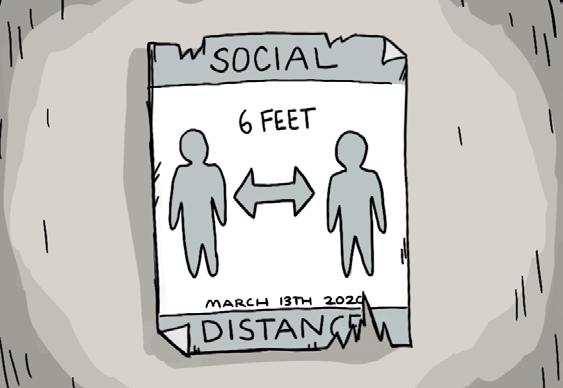
BY RACHEL GAUER features@theaggie.org
A world permeated with mask mandates, the “six-feet rule,” superspreader events and social distancing began fve years ago this month. Many Americans name Friday, March 13, 2020 as the start of it all — the day President Donald Trump declared COVID-19 to be a national emergency within the U.S. — which also marked the fnal business day of “normal” operations. For many, this day symbolizes the last time students would see their peers and teachers in a traditional classroom setting, the last day some employees set foot in the ofce and the fnal moments of pre-COVID-19 life. What seemed to be an extended spring break for students quickly turned into a global pandemic and left everyone in social isolation across the globe.
Five years later, the social impacts of COVID-19 remain present in many of our institutions, including in university settings like UC Davis. Countless workplaces have shifted to work-from-home options and academia has increasingly utilized Zoom and other online communication methods for teaching. Meetings, discussions and other face-to-face interactions are now often replaced by emails or online meetings, diminishing the small talk and human interaction that come with being in-person. Seth Frey, a professor of communication at UC Davis, teaches a mix of both online and inperson courses in the Department of Communication, including CMN 152V: Social Science with Online Data, an online cross-campus course, and CMN 151: Simulating Communication Processes, an in-person course.
Frey commented on the importance of face-to-face communication in an academic and work setting both for students and faculty.
“[Something] that I’m most interested in is the social conversation, still very much alive, around the importance of showing up in person,” Frey said via email. “We seem to agree it matters a lot and yet it’s harder now to expect it. Tis isn’t just about students meeting professors’ expectations for physical attendance.”
Frey also discussed the obstacles that faculty have faced following the pandemic.
“Among ourselves, faculty are still navigating the challenge of establishing shared norms, values, and expectations for when we think physical meetings are most important, and how to go about making them happen reliably,” Frey said.
Undoubtedly, remote options for meetings and other academic activities have brought many elements of convenience to students and faculty. Online, asynchronous courses allow students to self-pace, while remote ofce hours allow professors to meet with students more frequently and at more convenient times.
Sacha Chickering, a secondyear mechanical engineering major, commented on this element of accessibility with online courses, emphasizing the importance of interpersonal interaction.
“Courses that ofer hybrid or online options can ofer some advantages to people living far away from school, but also I personally miss being more in person,” Chickering said. “I think in person is better — something about being online makes it feel less connected and like you could be doing it from anywhere in the world.”
Tough many current UC Davis undergraduate students experienced the start of the pandemic prior to their time at Davis, students at the time could follow their courses from truly anywhere in the world, as schools were exclusively online.
speaker Jackson O’Donnell from UC Santa Cruz shares the ongoing research on dark
STEPHANIE CHAN / AGGIE

BY EKATERINA MEDVEDEVA science@theaggie.org
You, me and everything that we are used to seeing around us is made up of matter. So is the gas and celestial bodies in outer space, like stars; In fact, we are partly made up of “star stuf” as a result of the long processes of star life cycles and the formation of the universe as we know it.
However, all of this regular matter, also called baryonic matter, that we can “see” (or rather detect directly) makes up only 5% of the content of the universe. A much larger portion — about 27%, according to the European Organization for Nuclear Research (CERN) — consists of so-called dark matter, the nature of which is still mostly shrouded in mystery. Unlike baryonic matter, dark matter does not emit electromagnetic radiation.
“Researchers have been able to infer [its] existence [...] only from the gravitational efect it seems to have on visible matter,” the study reads.
While the standard cosmological model (also known as ^CDM) that postulates the existence of cold dark matter (CDM) has been successful in making predictions about our universe on large scales, there remains a lot of discrepancies on the small scale level. Tis has spurred additional extensions of dark matter studies that consider diferent variations on its properties.
In late February, a guest speaker from UC Santa Cruz — Jackson O’Donnell, who is a physics Ph.D. student — gave a talk at a UC Davis cosmology seminar about ongoing work in self-interacting dark matter (SIDM) research.
“In ^CDM, we say that cold dark matter is an ideal gas,” O’Donnell said. “So if [it is made up of] particles, those particles just fy by each other and they only interact through gravity. With the self-interacting dark matter, [we are] saying that if two dark matter particles fy close enough to each other, they can bounce of of each other. So, the large scale structure of the universe stays exactly the same, because in most of the universe the dark matter is thin enough that [its particles] are never going to interact with each other anyway. [Instead, SIDM] really [shows efects] inside of Halos of dark matter, where there’s enough of it [for them] to possibly bounce of of each other.”
One of the things that the ^CDM model fails to explain, which SIDM can make up for, is the existence of supermassive black holes very early on in the universe. Tese have been confrmed by observations from several telescopes, including the James Webb Space Telescope (JWST). Tis problem is aggravated by the fact that intermediatemass black holes are scarcely observed in the universe, which creates a gap in our knowledge regarding how lightweight black holes (which are relatively wellstudied) and how supermassive black holes form.
A study led by M. Grant Roberts,
FROM PAGE 4
Books like Marissa Meyer’s “Cinder” also retell the classic story with a modern twist, but at its core, it uses the same basic framework.
Tese stories prevail for a reason; Tey’re widely applicable and broad enough to encompass a variety of situations that carry mass appeal but are still human enough to be timeless. Te same set of core structures, while they have their similarities, are still decorated in diferent ways so that they don’t become tired. Tat’s the beauty of it; it’s a cycle of inspiration and innovation.
Tere’s more to the story though. Even the original authors of the theory point out two more plots that they don’t emphasize because of how rare they are, though they do exist. Te retelling of common themes permeates deep into our canons of ancient and modern literature and, as time goes on and art develops the throughlines, they become ever more intrinsic. Every story owes its weight to those that came before it, not just to its creator. In this way, the whole world of literature is as ancient as humanity itself — quite literally a tale as old as time.
Disclaimer: Te views and opinions expressed by individual columnists
A recent study identifies neural pathways driving antianxiety effects associated with psychedelics
BY KATELYN BURNS science@theaggie.org
Psychedelics are a class of hallucinogenic drugs that can cause an altered mental state. While there’s currently very little known about the mechanisms of these drugs and the extent of their efects, there has been interest in their potential therapeutic uses.
Dr. Jessie Muir, a postdoctoral scholar in the Kim Lab at Princeton University, said traditional treatments for anxiety can be inefective.
a doctoral student at UC Santa Cruz, explored “the possibility that a fraction of the cosmological dark matter could be ultra-strongly self-interacting, [which] would imply that gravothermal collapse [occurred] at early times in the cores of dark matter halos, followed by accretion,” resulting in formation of supermassive black holes.
“Te dark matter self-interaction is a necessary component because the dark matter particles need a way to scatter of one another, much stronger than just gravitational interactions,” Roberts said. “Tis scatter causes the dark matter to bunch up in the very inner central regions of the galaxy, which allows them to collapse into supermassive black hole seeds.”
While this study considers SIDM on dwarf galaxy scales, on the other side of the spectrum, O’Donnell’s talk at UC Davis primarily was concerned about constraints on dark matter selfinteraction in galaxy clusters. The quantity of interest that is constrained is the cross section of self-interaction, measured in centimeters squared per gram, which in simple terms describes how close the dark matter particles have to be to interact with each other.
Te current constraints are very di f erent on these small scales and big scales, [which] naively seems inconsistent, but could actually make sense if there is a simple velocity dependence, [where if] dark matter particles are fying by each other slowly, they’re likely to interact and they don’t need to be quite so close to bounce of of each other,” O’Donnell said. “But if they’re moving fast, it could be that they have a lower cross section, [so] they need to almost exactly hit each other to interact.”
For these types of studies, strong gravitational lensing (where light gets bent due to a curvature of spacetime created by a massive object on its path) turns out to be an extremely powerful tool, as it allows researchers to measure the mass enclosed in a particular lensing region, allowing them to learn about the amount of dark matter contained within it.
“We have more [Integral Field Units] (IFU) data, [which is a kind of] spectroscopy where you get spatial and spectral information,” O’Donnell said when describing the future prospect of his work. “My advisor and I had a night of observing on one of the Keck telescopes back in September and we used an instrument called [Keck Cosmic Web Imager] (KCWI), which [UC Davis Department of Physics Professor]
Tucker Jones’ group [...] helped us out a lot with that. So, we have data on a few more strong lensing galaxy clusters sitting around waiting for us to do a similar analysis on.”
Besides SIDM, there are many other extensions — such as axion dark matter, warm dark matter and others — that o f er unique potential explanations for many phenomena in our universe that for now remain unknown, which nevertheless ofer an exciting outlook on the future of astrophysics.
belong to the columnists alone and do not necessarily indicate the views and opinions held by Te California Aggie NEWSOM FROM PAGE 4
In a February 2025 article from the Te Davis Enterprise, Davis Police Chief Todd Henry provided a statement. Tere’s this general sense of it not being safe, especially during nighttime hours,” Henry said. “If they qualify for [Proposition] 36, we’re defnitely using the law.” Here, Henry points to unhoused people as the reason for this unsafe atmosphere.
Prop. 36 was passed this last election cycle, turning petty theft and drug usage back into a felony. Tese two statements imply that the Davis police are intentionally targeting unhoused people with their enforcement of this law.
DDBA President Kevin Wan explained how the DDBA wants to “[tackle] the challenges of crime and homelessness” because “our very livelihoods depend on an attractive and safe downtown.”
“Downtown safety and cleanliness are two of the biggest priorities for me and the DDBA in general,” DDBA Executive Director Brett Lee said. Both of these appear to be
“Despite [anxiety and depression’s] prevalence and their burden on the population, traditional treatments for anxiety and depression are inefective in a large part of the population,” Muir said via email. “Even [for] people in which treatment does work, there is a high risk for recurrence.”
Psychedelics have been found to promote changes in the prefrontal cortex that can have therapeutic efects, and they have shown promise as a non-traditional treatment for anxiety. Of course, in certain situations, psychedelics can have the opposite efect, inducing anxiety.
“When we discuss psychedelics as potential therapeutics, it is important to isolate these therapeutic efects, as it would be benefcial to be able to treat [anxiety] with as little adverse side efects as possible,” Muir said.
In a study published in Science, a
peer-reviewed journal in the American Association for the Advancement of Science, in November 2024, mice were used to study the neural pathways driving the therapeutic anti-anxiety efects of psychedelics.
Dr. Christina Kim is an assistant professor of neuroscience and bioengineering at Princeton University and the lead researcher of the Kim Lab.
“If we could isolate distinct neural pathways that just drive potential benefcial behavioral efects, without driving the hallucinogenic effects, these could inform new therapeutics that ultimately could be safer and more precise,” Kim said via email.
In the study, neurons in the medial prefrontal cortex that were active following a psychedelic injection were tagged and reactivated after the drug was no longer afecting the mice. It was noted that the anti-anxiety efects occurred without the hallucinogenicassociated head twitch responses.
“Tis was also a little unexpected, as we thought that the neurons in the medial prefrontal cortex may also be involved in driving the hallucinogeniclike efects,” Kim said.
Te prefrontal cortex has been the focus of a lot of work, including this study, regarding the therapeutic efects of psychedelics.
Te medial prefrontal cortex is one that has been well-studied in rodents; hence we focused on it [in this study],” Kim said.
However, other brain regions like the ventral hippocampus, as noted in
a recent paper published in Neuron in November 2024, are also thought to be involved in the therapeutic efects of psychedelics.
“We still do not know exactly how the hallucinogenic efects of these drugs are instantiated in the brain,” Kim said. “It’s possible that it involves many brain areas; this is something that many researchers are actively working on.” It should be noted that while the study had implications for the therapeutic use of psychedelics without the hallucinations, the specifc psychedelic from this study — 2,5-dimethoxy-4-iodoamphetamine (DOI) — wasn’t being evaluated as therapeutic.
Te psychedelic we studied in our paper is not one that is being evaluated as a therapeutic in clinical trials,” Kim said. “Our study was very much a basic research-focused study.”
Regarding future clinical trials and other research-focused studies, new tools and technologies are being developed now that will open new possibilities in psychedelic research.
“We are actively engineering new types of molecular technologies that would allow us to identify specif c proteins that may be involved in psychedelic signaling in activated neurons,” Kim said.
The possibilities of expanding research is a source of inspiration for Muir.
“Tere’s a lot to learn about these drugs and we have more tools now than ever before to study them,” Muir said.
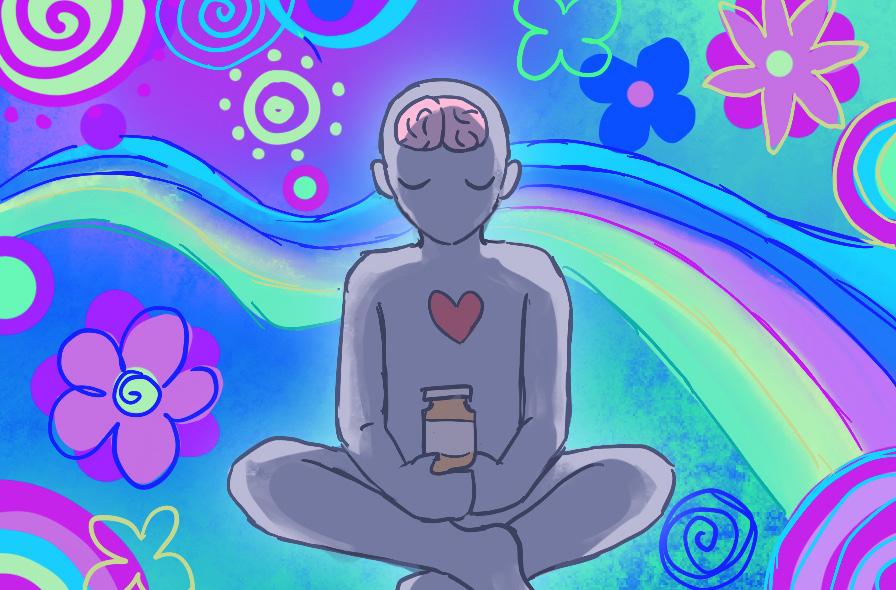
unassuming statements at frst glance, but it’s important to remember whose “safety and cleanliness” they are talking about. When they say “safety,” they mean the average Davis resident; Tey do not mean the unhoused population who are more vulnerable to violence, weather and displacement than anyone else in town.
Similarly to Newsom, Wan and Lee’s priorities are not to actually provide support to our most vulnerable population. T ey would rather the town appear “attractive and safe” than encourage the local government to make it safe for unhoused people.
Davis’ use of law enforcement against the unhoused population, alongside Newsom’s push to evict encampments, violates our most vulnerable community’s basic human rights.
Genuinely, I believe Newsom is a lost cause. No matter how many experts tell him that removing encampments is not the solution, he will stand frm. Tis is why I encourage you all to speak up to our local government in solidarity with our unhoused community in Davis. Tearing apart encampments and criminalizing homelessness is not the solution. I encourage Mayor Bapu Vaitla to stand with the San José and Los Angeles mayors against Newsom’s N-1-24 ordinance and to prioritize providing every unhoused person, including those who have been previously incarcerated and are current drug users, with shelter. We cannot let our own Davis community members be removed or incarcerated just to make the town “look good.”
Disclaimer: Te views and opinions expressed by individual columnists belong to the columnists alone and do not necessarily indicate the views and opinions held by Te California Aggie.
Ava Jabbari, a third-year international relations and environmental policy and planning double major, serves as the director of outreach. As part of her role, she has worked to strengthen ties between past and present members, ensuring that the legacy of ISO continues to grow.
T e ISO has been around for decades,” Jabbari said.
“Sara Ruebelt — who is actually faculty at the university at the moment, she’s a community counselor — was a part of the ISO back when [she was a visiting scholar in the Psychology Department], which was in
the early 2000s.” The longstanding presence of the Iranian Students Organization at UC Davis speaks to the importance of cultural organizations in fostering community and preserving heritage. Over the years, ISO has provided Iranian and Iranian-American students with a home away from home, ofering a space where they can celebrate their traditions, share their experiences and introduce Persian culture to the broader campus community. With a commitment to fostering community, the ISO hopes to continue growing its presence on campus, ensuring that Nowruz remains a cherished tradition for years to come.
As spring approaches and the new year begins, Nowruz at UC Davis stands as a testament to the enduring importance of tradition, unity and the celebration of new beginnings.
FROM PAGE 10
Margaret Lonergan, a fourth-year
human development major, began her undergraduate studies in September 2021 following a year of remote learning for her fourth year of high school. She refected on the difculty of forming connections with other students prior to moving to Davis, which she said were solely made on social media and refected the online nature of relationships at the time.
“Making connections solely with technology was really hard — some people aren’t great texters and some people just aren’t great at communicating virtually,” Lonergan said. “It’s hard to know if you’re getting the real personalities of people online.”
Lonergan has opted to take some online classes despite the lack of social interaction and highlighted aspects that have drawn her to online classes.
“It’s easier to ‘get by’ in a lot of the virtual classes, since they tend to be a lot of busy work,” Lonergan said. “But, it’s easier to zone out when classes are virtual and there is no one holding you accountable. I think I prefer the social interactions, which you don’t really get from virtual classes.” Tough the pandemic eliminated some elements of valuable social connection, some elements of online teaching and learning have allowed for increased productivity for some, as less time is spent for commutes or other time consuming work-related activities.
Henry Bandettini, a fourth-year psychology major, noted that the skills he gained from online learning during
the pandemic during his fourth year of high school were crucial to developing his time management. Now, he said the e f ects of online learning have transferred over to tangible skills in his workplace and in academic settings.
“I’m an account executive [in] Downtown Davis, and some days I work remotely and some days I’m in person,” Bandettini said. “I think the fexibility that I’ve been given throughout high school with [COVID-19] and then taking some remote and hybrid classes at Davis has taught me to manage my time in a way that I can be productive and get stuf done, but at the same time, I have fexibility and take time of when I can. I didn’t expect the time management that came with [COVID-19] to play such a big role in not only my college experience but overall career.”
COVID-19 has certainly had lasting impacts on professional settings and interpersonal connection over the past fve years and continues to have health impacts worldwide. T ough the fexibility and online options have eliminated unnecessary time spent, the social implications of previous social distancing may be more implicit — yet nevertheless prominent.
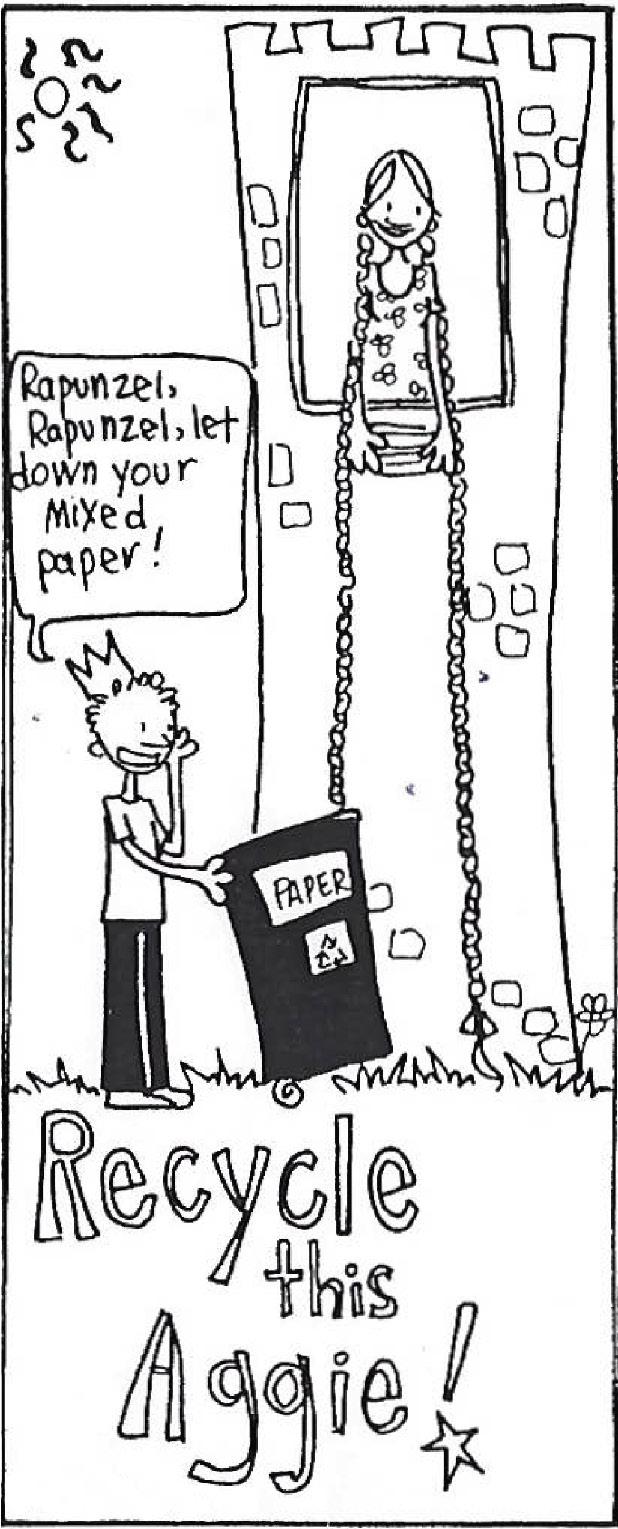
The Aggies come out on top over Villanova University and UC San Diego on March 2 and 3
BY THEO KAYSER sports@theaggie.org
On March 2, the UC Davis men’s tennis team traveled south to La Jolla, California to play in the Pacifc Coast Doubles Championship.
Te tournament was played for its 136th time this year as they drew top universities from California and beyond to compete. Te weekend consisted of a doubles tournament along with standard one-on-one matchups between universities.
For UC Davis, this meant participation in the tournament by Lucas Bollinger, a third-year economics major, and Kaveh Taheri, a frst-year undeclared major. Te Aggies faced of against Villanova University and UC San Diego, where UC Davis came out as victors in both of these matches.
UC Davis’ duo of Bollinger and Taheri found early success and advanced to day two before being eliminated. Te pair was defeated in the round of 16 by a duo from Bucknell University.
UC Davis squared off against
Villanova University on Sunday morning and dominated across the board, sweeping the day 4-0. Tis came through a victory in the doubles point early in the day, followed by another three consecutive victories in singles matches.
The doubles point was secured through victories in the frst two sets, the third set unfnished. Te frst Aggie victory was won by duo Perry DiGiulio, a frst-year undeclared major, and Sam De Vries, a fourth-year communications major. Te match was won by a decisive score of 6-1. Tey were soon followed by Bollinger and Taheri, who secured the tournament point for UC Davis with a 6-2 victory of their own.
Te Aggies similarly dominated the singles events, coming away with another sweep. Te matches were won by Taheri and Bollinger, who earned their second victories of the day, along with Eduardo Gonzalez, a second-year biochemistry and molecular biology major. All three players won their matches in just two sets, the match played to the best of three.
After dominance on day one, the Aggies were contested slightly more on
Monday, March 3 by UC San Diego, though still won the tournament day 4-2. UC San Diego began on top, winning two of three doubles matches to secure the frst tournament point. Bollinger and Taheri were the frst to fnish, taking their set 6-2 before UC San Diego won the following two sets.
Te Aggies responded to this early deficit with ferocity in the singles section, winning four of the fnal fve matches to claim victory for the second consecutive day.
Victors for UC Davis in the singles on Monday were Taheri, Bollinger, De Vries and Gonzalez. Taheri continued his impressive tournament, winning his match in two sets yet again. Te remaining three Aggies claimed victories in three sets.
Tis tournament proved to be a strong weekend for the UC Davis Aggies as they had stellar performances across the board. After a successful run at the Pacifc Coast Doubles Tournament, the men’s tennis team will be looking to continue their winning streak in future matches as they face of against Eastern Washington University on March 13.
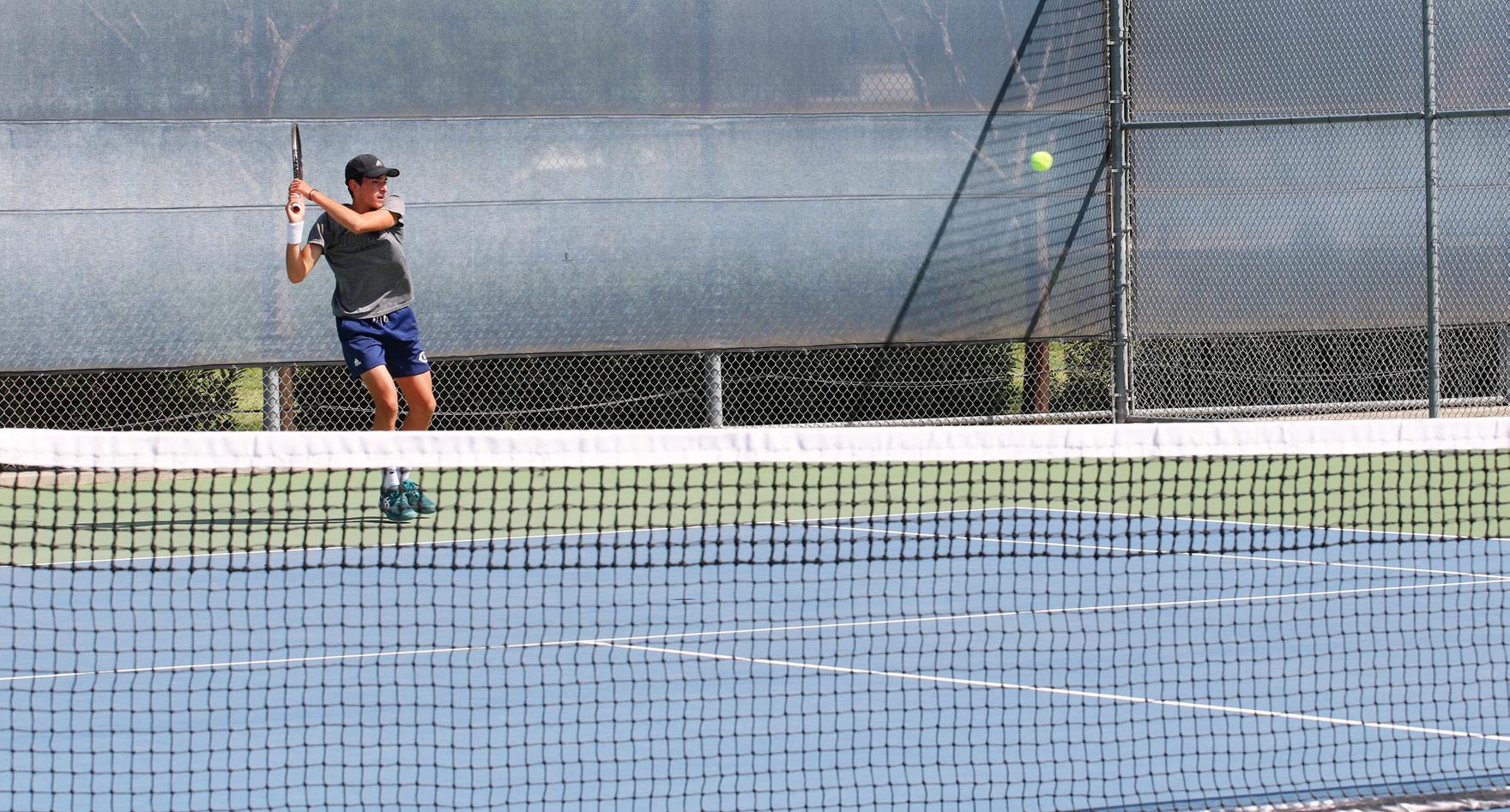
Getting involved can help build strong friendships
BY DIEGO CERNA sports@theaggie.org
Intramural sports at UC Davis are a great way to get involved with student life outside of academics. Te university o f ers over 30 di f erent leagues for students to play in throughout the year, including traditional sports such as basketball, soccer and volleyball, as well as non-traditional sports such as blind bocce ball, esports leagues and tube polo.
Jacob Michels, a third-year human development major, has played soccer, volleyball and basketball throughout his three years at college.
“My favorite part about being on an intramural team is having a day to look forward to with a great group of teammates,” Michels said. “It’s easy to make friends and get better at a sport with the right people beside you.”
Koyla Alvarez Thompson, a fourth-year history major, has played intramural soccer for four years and intramural basketball for two years.
“I think intramural sports are a good staple in my weekly routine,” Tompson said. “It’s a social outlet to remain active, keeping me in a good
head shape to excel in my academic pursuits.”
Tere are diferent types of leagues students can choose from. Te OpenRec leagues are for players who might not have as much experience with a sport or just want to do a sport recreationally. Open-Rec is open to any player, with Co-Rec as another version not organized by gender, with a specifc ratio of male and female players, to compete on the same team.
Competitive leagues are for players who have more experience or are more skilled at the sport; Tese leagues have seedings for single-elimination playofs.
Te only requirement for students to join is to have a Rec Sports Pass, which is ofered at $20 per month, or $60 per academic year. Rec Sports also accepts applications from students who sign up for the Campus Recreation Wellbeing Fee Waiver, which allows students to join free of cost. For students short on time, there are also one-day tournaments as opposed to quarterlong leagues.
Tompson also enjoys participating in poker tournaments, recently competing in one of their winter tournaments.
said. “It was a one-day event and it was organized very efciently.”
Tere are, however, some issues experienced by students with how the leagues are organized. One problem cited by students in intramural leagues is teams quitting early in the season.
“It’s unfortunate that some teams will forfeit, as it messes up the competitiveness of the league,” Andrew Jones, a fourth-year plant biology major, said.
A potential solution that Jones had would be to enforce the $10 fee early into the season.
“It would encourage other people to join the league in the middle of the season, [as well as] not wasting money,” Jones said.
Another potential problem is the scheduling of games between teams, particularly during the playofs.
“Te only issue I’ve had in the past is that playof games are scheduled at diferent times than seeding games, which afected our team’s availability,” Tompson said.
Michels echoed this point and described the consequences of scheduling diferences.
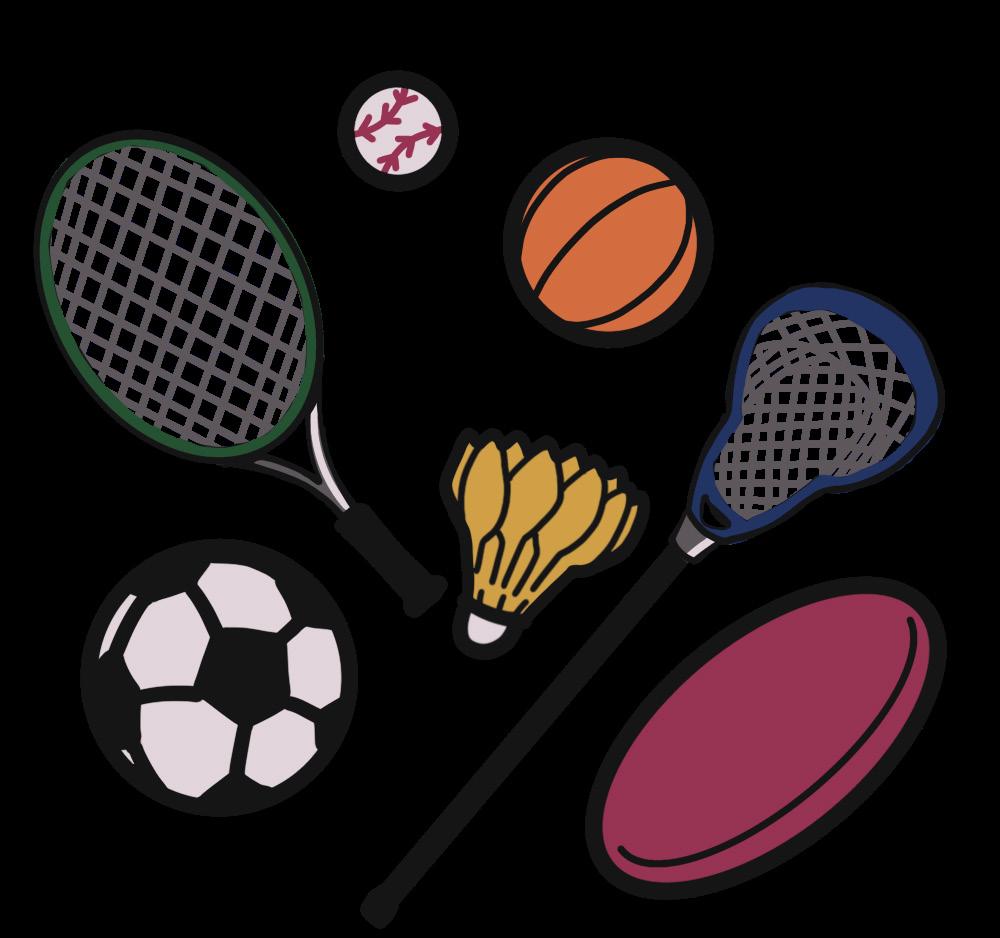
“What ends up happening is a lot of people can’t make the playof games or people have to skip class or work to matches,” Michels
Despite potential organizational downsides to intramural sports, the athletic opportunity is also a great outlet for remaining active and maintaining a well-balanced lifestyle throughout the
“For other students who want to join, I would say to try it out even if you don’t have a friend group to go into it with,” Jones said.
In the end, intramural sports at UC Davis ofer more than just a chance to compete — they provide a space to connect, stay active and create lasting friendships. So, for students looking to meet new people, try something new or simply engage in athletic activity, don’t hesitate to sign up and get involved.
UC Davis women’s basketball secures the last home game of the season, winning 74-66

UC Davis women’s basketball player, Ryann Bennett, plays at the game against University of Hawaii at Manoa on March 1. (Aggie File)
BY COLINA HARVEY sports@theaggie.org
On March 1, the UC Davis women’s basketball team took on the University of Hawaii at Mānoa Rainbow Wahine. As it was their fnal home game of the season, the game was deemed Senior Night, honoring the team’s graduating fourth-year players. Te Rainbow Wahine have been putting on impressive performances this season, making them a competitive matchup for the UC Davis Aggies. Up until Feb. 27, when they were beaten by UC Riverside, the Rainbow Wahine were on a 14-game winning streak, including a win against the Aggies on Jan. 23. However, the Aggies have also had a lot of success this season, taking many victories and even going on an eightgame winning streak.
Te Aggies got of to a shaky start as the game began, and despite the efort, the players struggled to score. For nearly fve minutes, the Aggies remained scoreless while Hawaii racked up 10 quick points.
Nya Epps, a third-year undeclared major and guard, fnally ended the scoring drought with a three-pointer. Another three-pointer from frst-year Ryann Bennett put the Aggies right back in the game. Even though the Aggies failed to net many of their shots in the frst quarter, they showed good of-ball hustle and movement.
On Hawaii’s last possession of the frst quarter, the Aggies played strong defense and ran out the Rainbow Wahine’s shot clock. Tis defensive performance allowed the Aggies to only trail by two going into the break.
In the second quarter, a threepointer followed by a layup by Avery Sussex, a frst-year undeclared major and guard, took the Aggies to their frst lead of the game. Te two teams traded points for a while with the score staying very even. However, for nearly six minutes in the quarter, the Aggies failed to make a single basket. Tis allowed Hawaii to make a nine-point run and lead by 10 at halftime. Going into the second half, the Aggies were determined to close the point defcit. Right out of the gate, Megan Norris, a fourth-year political science major and center, netted a threepointer from the corner of the court. A pair of layups from Epps left the Aggies
just three points behind Hawaii. Sydney Burns, a fourth-year international agriculture development major and guard, began to heat up in the third quarter, as a steal followed by a layup on the other end of the court tied the game. Burns made a mid-range jumper on the next play, allowing the Aggies to gain the lead.
Te crowd’s excitement grew when Norris made a three-pointer, putting the Aggies ahead by fve points. UC Davis’ momentum grew in the third quarter, as the crowd became more and more engaged. However, the Rainbow Wahine managed to come back, turning the defcit against the Aggies by 10 points.
Tova Sabel, a fourth-year psychology major and guard, and Burns were the stars of the fourth quarter, both making clutch plays. Sabel shined early with a steal and seven points in the frst six minutes of the quarter.
Ten, Burns took over the court for crunch time. With three minutes to go, Burns stole a Hawaii inbound and hurled it down the court to Epps for a game-tying score. She then went on to bank in a two-pointer and tip a crucial rebound to Norris.
With the game tied at 60-60, Hawaii fouled Epps on a layup, and she made the free throw. Hawaii fought back with a two-pointer on the other end.
Ten, Sabel made a three-pointer as the shot clock ran down, increasing the lead to four points for the Aggies with less than one minute to go. In the last 30 seconds, Burns was fouled. Te Aggies narrowly held their lead, thus making these free throws crucial. Burns made both, efectively winning the game for the Aggies. Te game ended with a score of 74-66.
Beating the No. 1 seed in the Big West Conference on Senior Night was a triumph for the Aggies. In addition to Burns and Sabel, Mazatlan Harris, a fourth-year animal science major and forward, and Bria Shine, a fourth-year neurobiology, physiology and behavior major and guard, were also honored as graduating players. Te women’s basketball team will have two more games in the regular season and will then head to Henderson, Nevada on March 12 for the Big West Conference Championships.